Information Systems in Organizations: A Case Study of Asda
VerifiedAdded on 2024/06/27
|22
|5542
|413
AI Summary
This report explores the role of information systems in organizations, focusing on the case of Asda, a leading supermarket in the UK. It examines the information needs of different functional areas within Asda, describes various types of information systems, and investigates current trends in using information systems to solve business problems. The report also evaluates the suitability of different information systems for various functional areas and identifies strategies for finding appropriate solutions. Finally, it presents and communicates findings on the importance of information systems for organizational success.
Contribute Materials
Your contribution can guide someone’s learning journey. Share your
documents today.
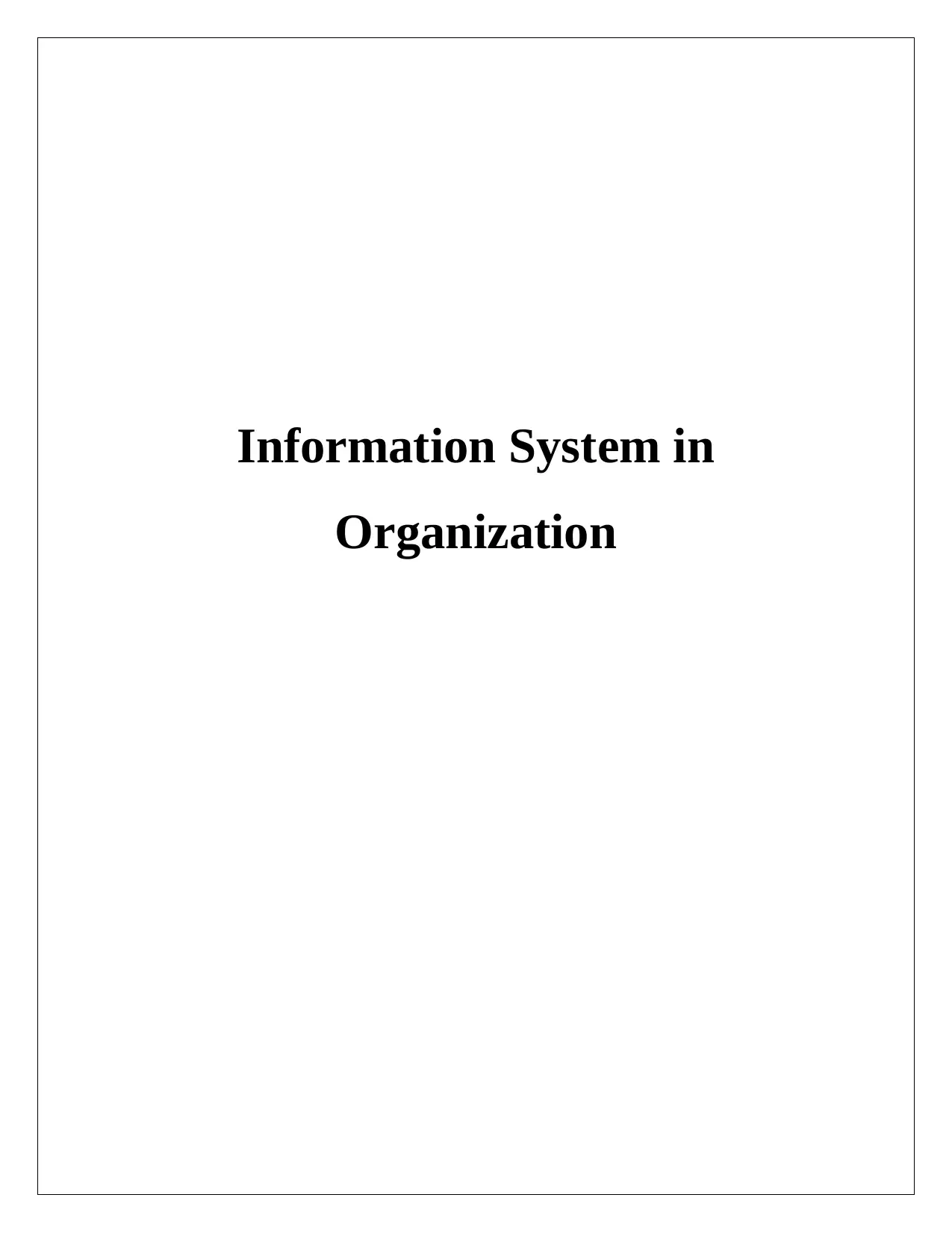
Information System in
Organization
Organization
Secure Best Marks with AI Grader
Need help grading? Try our AI Grader for instant feedback on your assignments.
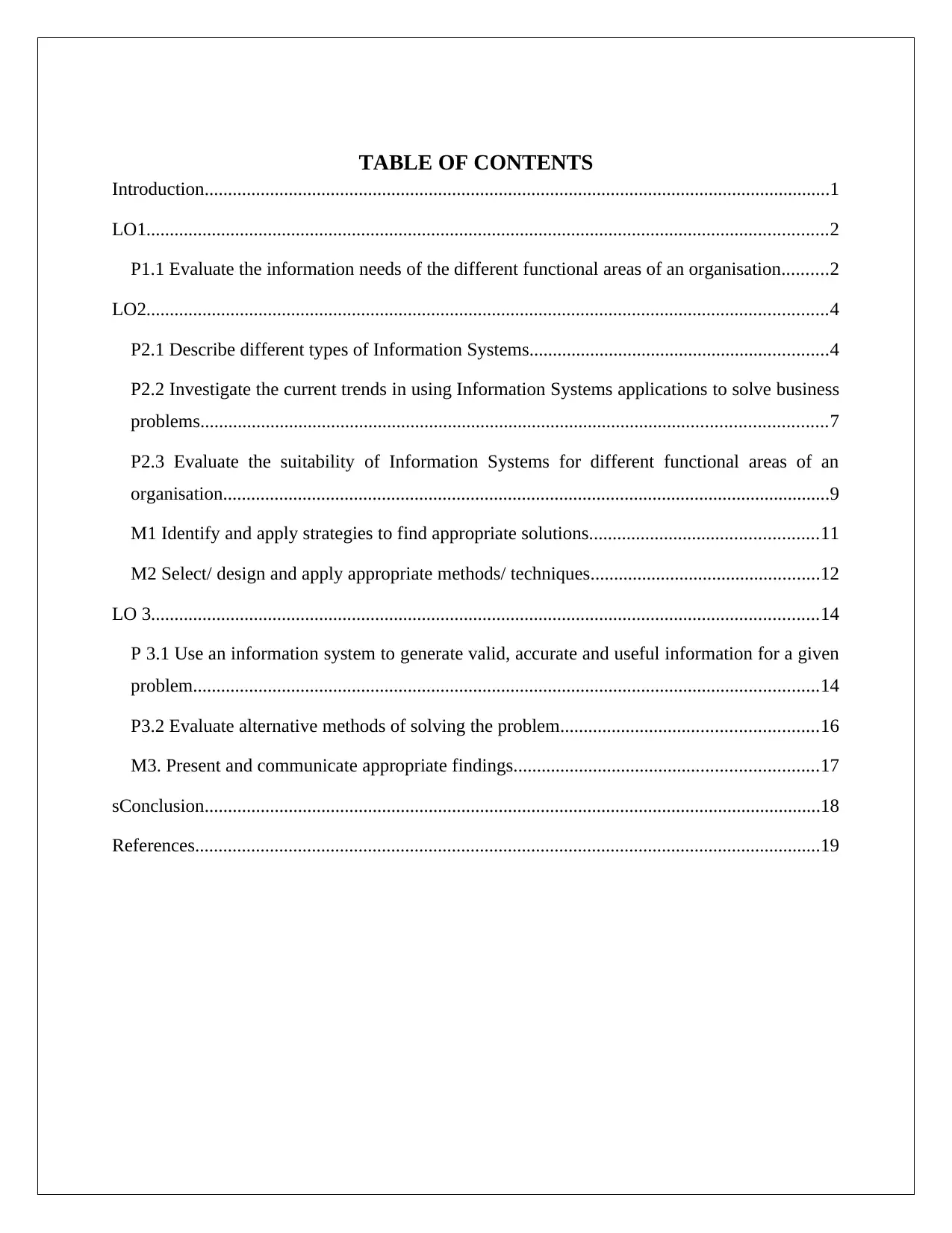
TABLE OF CONTENTS
Introduction......................................................................................................................................1
LO1..................................................................................................................................................2
P1.1 Evaluate the information needs of the different functional areas of an organisation..........2
LO2..................................................................................................................................................4
P2.1 Describe different types of Information Systems................................................................4
P2.2 Investigate the current trends in using Information Systems applications to solve business
problems......................................................................................................................................7
P2.3 Evaluate the suitability of Information Systems for different functional areas of an
organisation..................................................................................................................................9
M1 Identify and apply strategies to find appropriate solutions.................................................11
M2 Select/ design and apply appropriate methods/ techniques.................................................12
LO 3...............................................................................................................................................14
P 3.1 Use an information system to generate valid, accurate and useful information for a given
problem......................................................................................................................................14
P3.2 Evaluate alternative methods of solving the problem.......................................................16
M3. Present and communicate appropriate findings.................................................................17
sConclusion....................................................................................................................................18
References......................................................................................................................................19
Introduction......................................................................................................................................1
LO1..................................................................................................................................................2
P1.1 Evaluate the information needs of the different functional areas of an organisation..........2
LO2..................................................................................................................................................4
P2.1 Describe different types of Information Systems................................................................4
P2.2 Investigate the current trends in using Information Systems applications to solve business
problems......................................................................................................................................7
P2.3 Evaluate the suitability of Information Systems for different functional areas of an
organisation..................................................................................................................................9
M1 Identify and apply strategies to find appropriate solutions.................................................11
M2 Select/ design and apply appropriate methods/ techniques.................................................12
LO 3...............................................................................................................................................14
P 3.1 Use an information system to generate valid, accurate and useful information for a given
problem......................................................................................................................................14
P3.2 Evaluate alternative methods of solving the problem.......................................................16
M3. Present and communicate appropriate findings.................................................................17
sConclusion....................................................................................................................................18
References......................................................................................................................................19
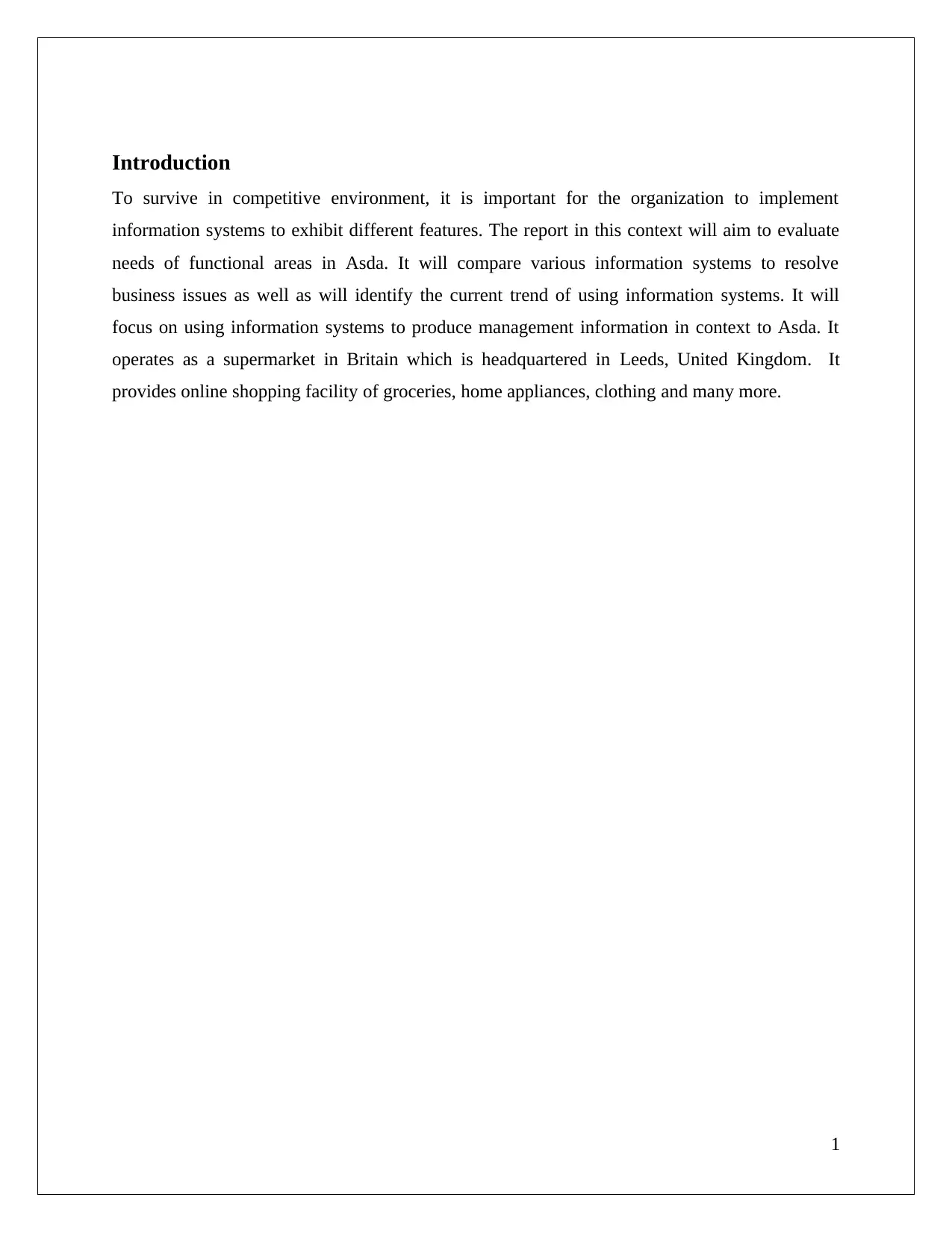
Introduction
To survive in competitive environment, it is important for the organization to implement
information systems to exhibit different features. The report in this context will aim to evaluate
needs of functional areas in Asda. It will compare various information systems to resolve
business issues as well as will identify the current trend of using information systems. It will
focus on using information systems to produce management information in context to Asda. It
operates as a supermarket in Britain which is headquartered in Leeds, United Kingdom. It
provides online shopping facility of groceries, home appliances, clothing and many more.
1
To survive in competitive environment, it is important for the organization to implement
information systems to exhibit different features. The report in this context will aim to evaluate
needs of functional areas in Asda. It will compare various information systems to resolve
business issues as well as will identify the current trend of using information systems. It will
focus on using information systems to produce management information in context to Asda. It
operates as a supermarket in Britain which is headquartered in Leeds, United Kingdom. It
provides online shopping facility of groceries, home appliances, clothing and many more.
1
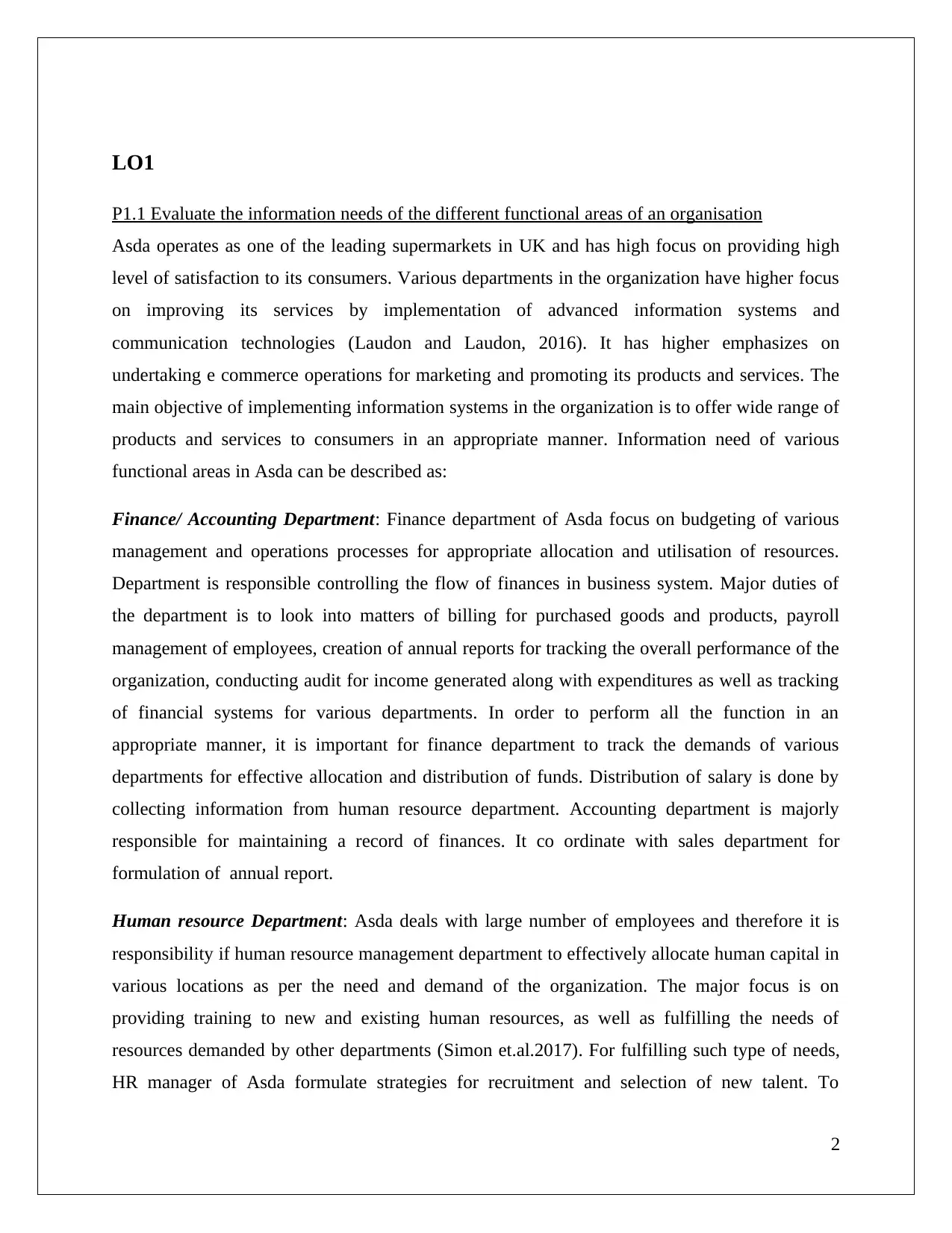
LO1
P1.1 Evaluate the information needs of the different functional areas of an organisation
Asda operates as one of the leading supermarkets in UK and has high focus on providing high
level of satisfaction to its consumers. Various departments in the organization have higher focus
on improving its services by implementation of advanced information systems and
communication technologies (Laudon and Laudon, 2016). It has higher emphasizes on
undertaking e commerce operations for marketing and promoting its products and services. The
main objective of implementing information systems in the organization is to offer wide range of
products and services to consumers in an appropriate manner. Information need of various
functional areas in Asda can be described as:
Finance/ Accounting Department: Finance department of Asda focus on budgeting of various
management and operations processes for appropriate allocation and utilisation of resources.
Department is responsible controlling the flow of finances in business system. Major duties of
the department is to look into matters of billing for purchased goods and products, payroll
management of employees, creation of annual reports for tracking the overall performance of the
organization, conducting audit for income generated along with expenditures as well as tracking
of financial systems for various departments. In order to perform all the function in an
appropriate manner, it is important for finance department to track the demands of various
departments for effective allocation and distribution of funds. Distribution of salary is done by
collecting information from human resource department. Accounting department is majorly
responsible for maintaining a record of finances. It co ordinate with sales department for
formulation of annual report.
Human resource Department: Asda deals with large number of employees and therefore it is
responsibility if human resource management department to effectively allocate human capital in
various locations as per the need and demand of the organization. The major focus is on
providing training to new and existing human resources, as well as fulfilling the needs of
resources demanded by other departments (Simon et.al.2017). For fulfilling such type of needs,
HR manager of Asda formulate strategies for recruitment and selection of new talent. To
2
P1.1 Evaluate the information needs of the different functional areas of an organisation
Asda operates as one of the leading supermarkets in UK and has high focus on providing high
level of satisfaction to its consumers. Various departments in the organization have higher focus
on improving its services by implementation of advanced information systems and
communication technologies (Laudon and Laudon, 2016). It has higher emphasizes on
undertaking e commerce operations for marketing and promoting its products and services. The
main objective of implementing information systems in the organization is to offer wide range of
products and services to consumers in an appropriate manner. Information need of various
functional areas in Asda can be described as:
Finance/ Accounting Department: Finance department of Asda focus on budgeting of various
management and operations processes for appropriate allocation and utilisation of resources.
Department is responsible controlling the flow of finances in business system. Major duties of
the department is to look into matters of billing for purchased goods and products, payroll
management of employees, creation of annual reports for tracking the overall performance of the
organization, conducting audit for income generated along with expenditures as well as tracking
of financial systems for various departments. In order to perform all the function in an
appropriate manner, it is important for finance department to track the demands of various
departments for effective allocation and distribution of funds. Distribution of salary is done by
collecting information from human resource department. Accounting department is majorly
responsible for maintaining a record of finances. It co ordinate with sales department for
formulation of annual report.
Human resource Department: Asda deals with large number of employees and therefore it is
responsibility if human resource management department to effectively allocate human capital in
various locations as per the need and demand of the organization. The major focus is on
providing training to new and existing human resources, as well as fulfilling the needs of
resources demanded by other departments (Simon et.al.2017). For fulfilling such type of needs,
HR manager of Asda formulate strategies for recruitment and selection of new talent. To
2
Secure Best Marks with AI Grader
Need help grading? Try our AI Grader for instant feedback on your assignments.
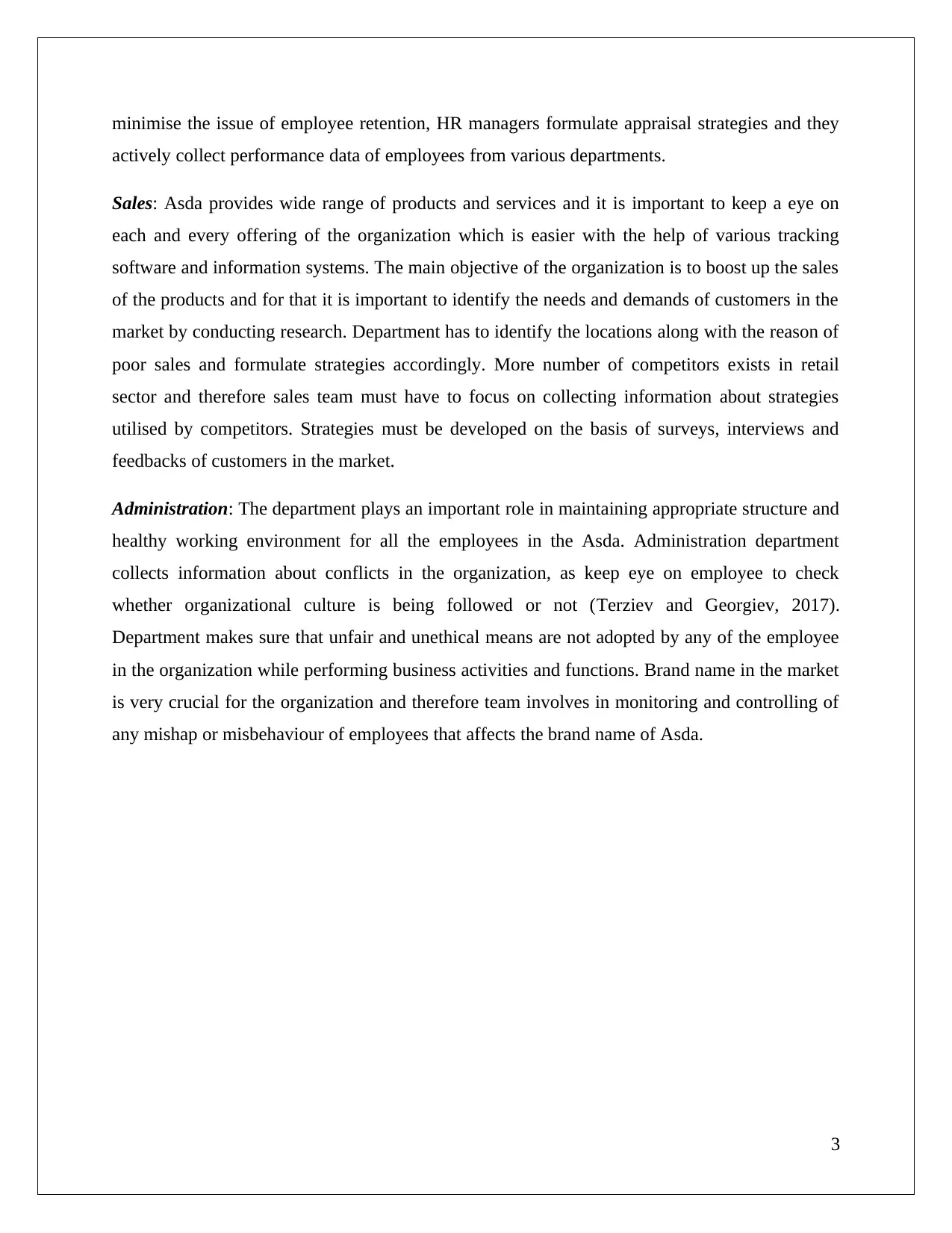
minimise the issue of employee retention, HR managers formulate appraisal strategies and they
actively collect performance data of employees from various departments.
Sales: Asda provides wide range of products and services and it is important to keep a eye on
each and every offering of the organization which is easier with the help of various tracking
software and information systems. The main objective of the organization is to boost up the sales
of the products and for that it is important to identify the needs and demands of customers in the
market by conducting research. Department has to identify the locations along with the reason of
poor sales and formulate strategies accordingly. More number of competitors exists in retail
sector and therefore sales team must have to focus on collecting information about strategies
utilised by competitors. Strategies must be developed on the basis of surveys, interviews and
feedbacks of customers in the market.
Administration: The department plays an important role in maintaining appropriate structure and
healthy working environment for all the employees in the Asda. Administration department
collects information about conflicts in the organization, as keep eye on employee to check
whether organizational culture is being followed or not (Terziev and Georgiev, 2017).
Department makes sure that unfair and unethical means are not adopted by any of the employee
in the organization while performing business activities and functions. Brand name in the market
is very crucial for the organization and therefore team involves in monitoring and controlling of
any mishap or misbehaviour of employees that affects the brand name of Asda.
3
actively collect performance data of employees from various departments.
Sales: Asda provides wide range of products and services and it is important to keep a eye on
each and every offering of the organization which is easier with the help of various tracking
software and information systems. The main objective of the organization is to boost up the sales
of the products and for that it is important to identify the needs and demands of customers in the
market by conducting research. Department has to identify the locations along with the reason of
poor sales and formulate strategies accordingly. More number of competitors exists in retail
sector and therefore sales team must have to focus on collecting information about strategies
utilised by competitors. Strategies must be developed on the basis of surveys, interviews and
feedbacks of customers in the market.
Administration: The department plays an important role in maintaining appropriate structure and
healthy working environment for all the employees in the Asda. Administration department
collects information about conflicts in the organization, as keep eye on employee to check
whether organizational culture is being followed or not (Terziev and Georgiev, 2017).
Department makes sure that unfair and unethical means are not adopted by any of the employee
in the organization while performing business activities and functions. Brand name in the market
is very crucial for the organization and therefore team involves in monitoring and controlling of
any mishap or misbehaviour of employees that affects the brand name of Asda.
3
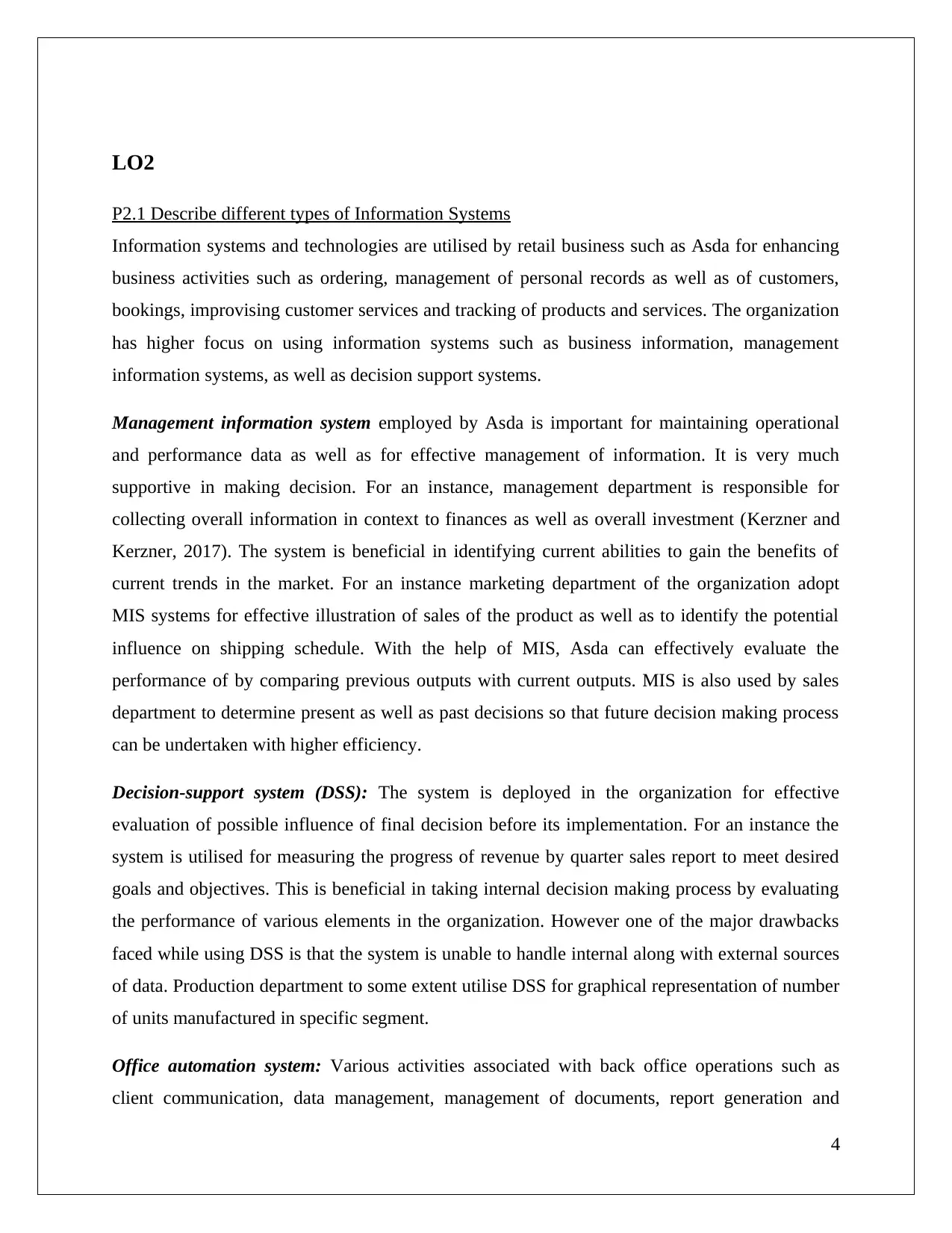
LO2
P2.1 Describe different types of Information Systems
Information systems and technologies are utilised by retail business such as Asda for enhancing
business activities such as ordering, management of personal records as well as of customers,
bookings, improvising customer services and tracking of products and services. The organization
has higher focus on using information systems such as business information, management
information systems, as well as decision support systems.
Management information system employed by Asda is important for maintaining operational
and performance data as well as for effective management of information. It is very much
supportive in making decision. For an instance, management department is responsible for
collecting overall information in context to finances as well as overall investment (Kerzner and
Kerzner, 2017). The system is beneficial in identifying current abilities to gain the benefits of
current trends in the market. For an instance marketing department of the organization adopt
MIS systems for effective illustration of sales of the product as well as to identify the potential
influence on shipping schedule. With the help of MIS, Asda can effectively evaluate the
performance of by comparing previous outputs with current outputs. MIS is also used by sales
department to determine present as well as past decisions so that future decision making process
can be undertaken with higher efficiency.
Decision-support system (DSS): The system is deployed in the organization for effective
evaluation of possible influence of final decision before its implementation. For an instance the
system is utilised for measuring the progress of revenue by quarter sales report to meet desired
goals and objectives. This is beneficial in taking internal decision making process by evaluating
the performance of various elements in the organization. However one of the major drawbacks
faced while using DSS is that the system is unable to handle internal along with external sources
of data. Production department to some extent utilise DSS for graphical representation of number
of units manufactured in specific segment.
Office automation system: Various activities associated with back office operations such as
client communication, data management, management of documents, report generation and
4
P2.1 Describe different types of Information Systems
Information systems and technologies are utilised by retail business such as Asda for enhancing
business activities such as ordering, management of personal records as well as of customers,
bookings, improvising customer services and tracking of products and services. The organization
has higher focus on using information systems such as business information, management
information systems, as well as decision support systems.
Management information system employed by Asda is important for maintaining operational
and performance data as well as for effective management of information. It is very much
supportive in making decision. For an instance, management department is responsible for
collecting overall information in context to finances as well as overall investment (Kerzner and
Kerzner, 2017). The system is beneficial in identifying current abilities to gain the benefits of
current trends in the market. For an instance marketing department of the organization adopt
MIS systems for effective illustration of sales of the product as well as to identify the potential
influence on shipping schedule. With the help of MIS, Asda can effectively evaluate the
performance of by comparing previous outputs with current outputs. MIS is also used by sales
department to determine present as well as past decisions so that future decision making process
can be undertaken with higher efficiency.
Decision-support system (DSS): The system is deployed in the organization for effective
evaluation of possible influence of final decision before its implementation. For an instance the
system is utilised for measuring the progress of revenue by quarter sales report to meet desired
goals and objectives. This is beneficial in taking internal decision making process by evaluating
the performance of various elements in the organization. However one of the major drawbacks
faced while using DSS is that the system is unable to handle internal along with external sources
of data. Production department to some extent utilise DSS for graphical representation of number
of units manufactured in specific segment.
Office automation system: Various activities associated with back office operations such as
client communication, data management, management of documents, report generation and
4

many more are easily handled with the help of Office automation system. The functions with the
help of system are performed with higher accuracy and reliability. It is very much supportive in
increasing the productivity and performance of the employees of Asda connected with back
office activities and operations (Gladence et.al.2017). It is regularly used by team members of
back office for higher efficiency of work. Major of the operations gets automated by using office
automation systems.
Transaction processing systems: the system deals with performing routine transactions that are
essential for conducting business operations. It includes wide range of systems that include
management of sales data, records of employee, manufacturing as well as shipping of products.
It gives real time information of processes transaction as well as keeps tracking of goods and
services. Major characteristics of TPS are performance, consistency and higher reliability, Asda
utilises transaction processing systems that includes financial transactions, as well as changes in
database and texting.
Expert systems: The systems are deployed to gain an advantage over decision making process
undertaken by human resources in the organization. These are implemented and adopted to
handle critical and complex situation with the support of effective reasoning and knowledge.
These are artificial intelligence systems with keen knowledge of subject in specific field. For an
instance, IT department of the organization have implemented expert systems along with neural
network for evaluation of data and provide appropriate recommendations.
Global Information System: Hardware and software systems are deployed in the organization
for storage, mapping, retrieval and analysis of geographical data (Burrough et.al.2015). ERP
systems is considered as global information system utilised by Asda Such type of systems are
used at global level to retrieve information in context to specific task and project. The systems
are beneficial in providing process as well as technologies that provides transparency and
performance management in projects undertaken by the organization.
Data warehouse systems: This is also referred to as enterprise data warehouse which is utilised
by retail organizations analysis and reporting of data which is one of the core components. The
system is utilised for collecting information of various departments at one common repository. It
5
help of system are performed with higher accuracy and reliability. It is very much supportive in
increasing the productivity and performance of the employees of Asda connected with back
office activities and operations (Gladence et.al.2017). It is regularly used by team members of
back office for higher efficiency of work. Major of the operations gets automated by using office
automation systems.
Transaction processing systems: the system deals with performing routine transactions that are
essential for conducting business operations. It includes wide range of systems that include
management of sales data, records of employee, manufacturing as well as shipping of products.
It gives real time information of processes transaction as well as keeps tracking of goods and
services. Major characteristics of TPS are performance, consistency and higher reliability, Asda
utilises transaction processing systems that includes financial transactions, as well as changes in
database and texting.
Expert systems: The systems are deployed to gain an advantage over decision making process
undertaken by human resources in the organization. These are implemented and adopted to
handle critical and complex situation with the support of effective reasoning and knowledge.
These are artificial intelligence systems with keen knowledge of subject in specific field. For an
instance, IT department of the organization have implemented expert systems along with neural
network for evaluation of data and provide appropriate recommendations.
Global Information System: Hardware and software systems are deployed in the organization
for storage, mapping, retrieval and analysis of geographical data (Burrough et.al.2015). ERP
systems is considered as global information system utilised by Asda Such type of systems are
used at global level to retrieve information in context to specific task and project. The systems
are beneficial in providing process as well as technologies that provides transparency and
performance management in projects undertaken by the organization.
Data warehouse systems: This is also referred to as enterprise data warehouse which is utilised
by retail organizations analysis and reporting of data which is one of the core components. The
system is utilised for collecting information of various departments at one common repository. It
5
Paraphrase This Document
Need a fresh take? Get an instant paraphrase of this document with our AI Paraphraser
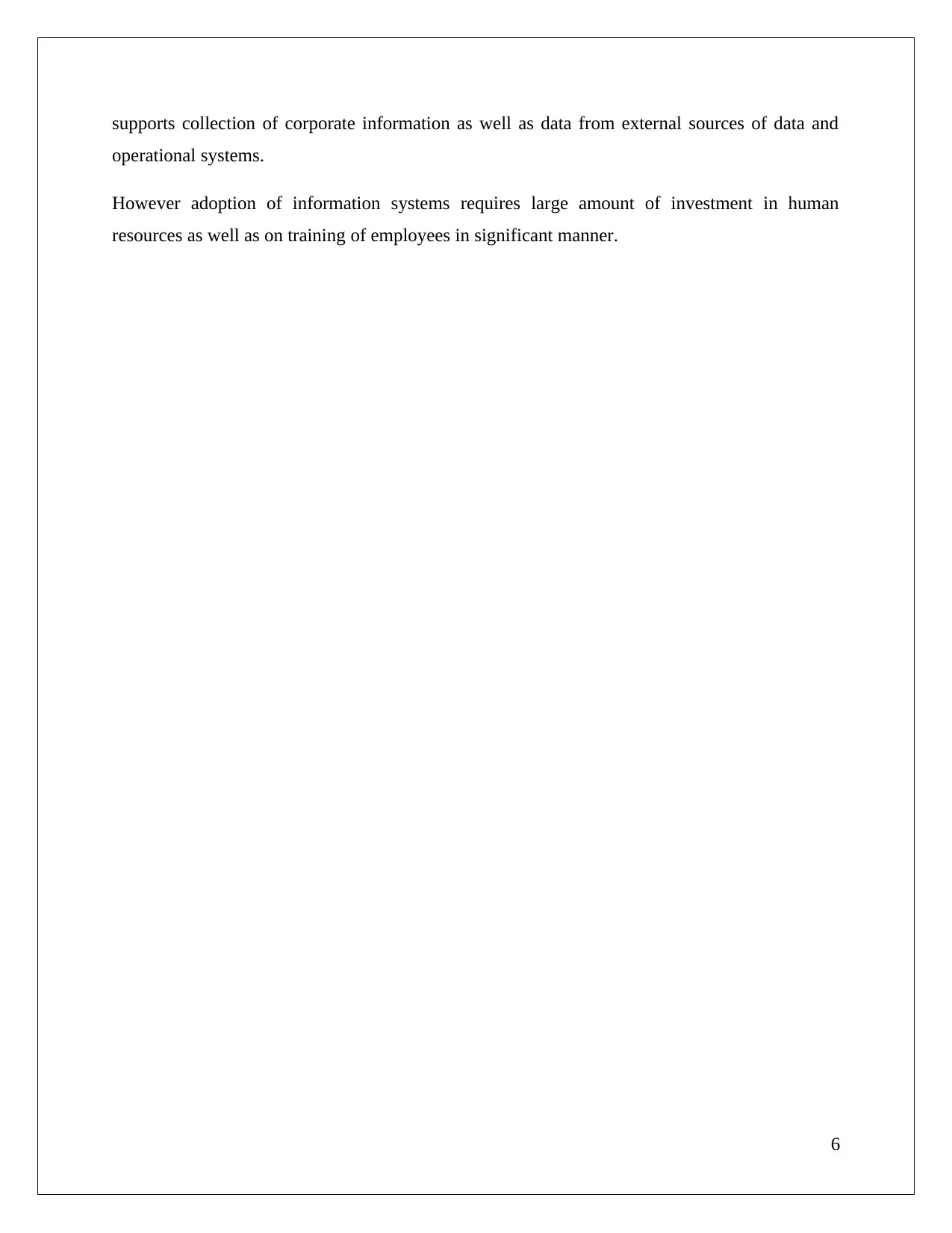
supports collection of corporate information as well as data from external sources of data and
operational systems.
However adoption of information systems requires large amount of investment in human
resources as well as on training of employees in significant manner.
6
operational systems.
However adoption of information systems requires large amount of investment in human
resources as well as on training of employees in significant manner.
6
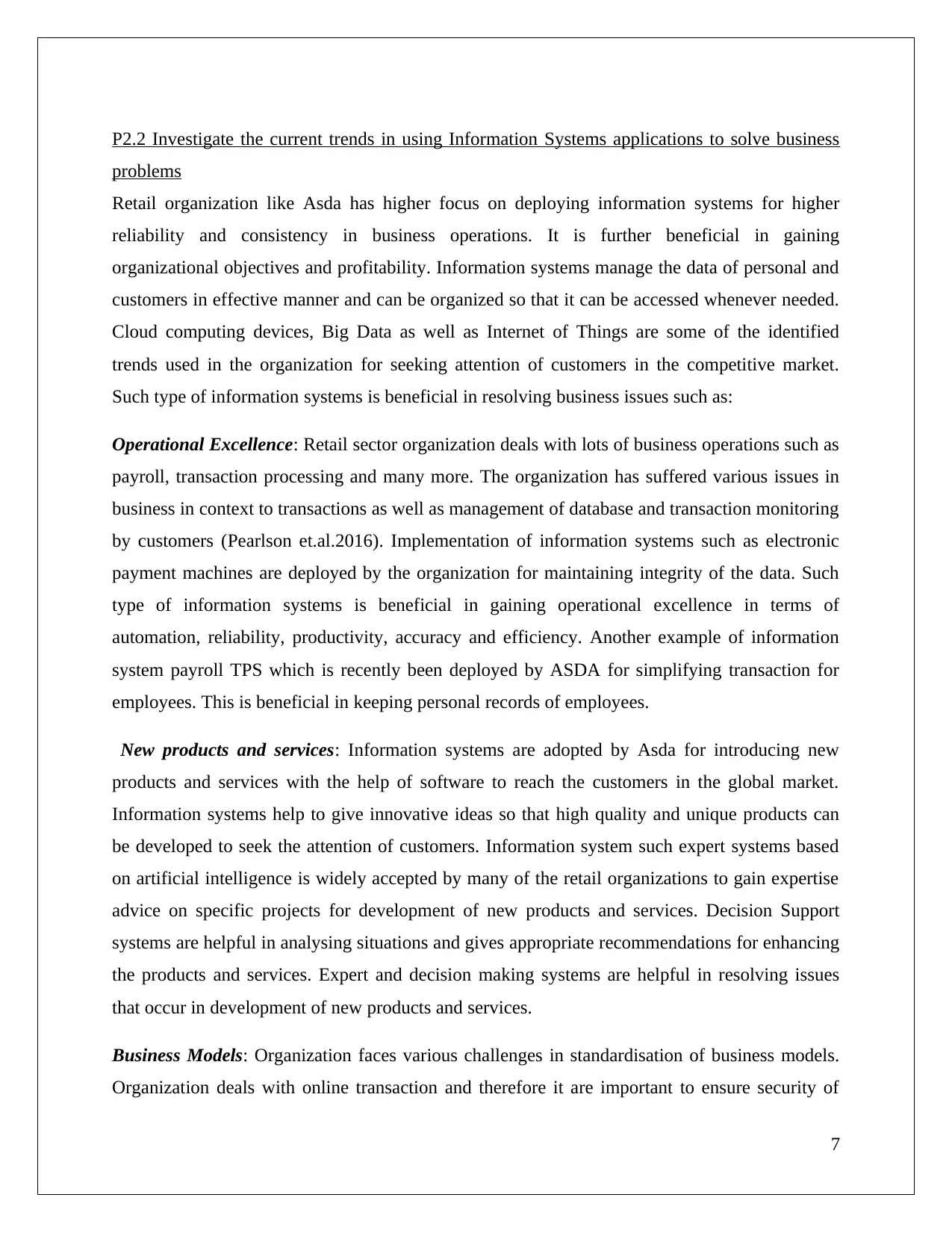
P2.2 Investigate the current trends in using Information Systems applications to solve business
problems
Retail organization like Asda has higher focus on deploying information systems for higher
reliability and consistency in business operations. It is further beneficial in gaining
organizational objectives and profitability. Information systems manage the data of personal and
customers in effective manner and can be organized so that it can be accessed whenever needed.
Cloud computing devices, Big Data as well as Internet of Things are some of the identified
trends used in the organization for seeking attention of customers in the competitive market.
Such type of information systems is beneficial in resolving business issues such as:
Operational Excellence: Retail sector organization deals with lots of business operations such as
payroll, transaction processing and many more. The organization has suffered various issues in
business in context to transactions as well as management of database and transaction monitoring
by customers (Pearlson et.al.2016). Implementation of information systems such as electronic
payment machines are deployed by the organization for maintaining integrity of the data. Such
type of information systems is beneficial in gaining operational excellence in terms of
automation, reliability, productivity, accuracy and efficiency. Another example of information
system payroll TPS which is recently been deployed by ASDA for simplifying transaction for
employees. This is beneficial in keeping personal records of employees.
New products and services: Information systems are adopted by Asda for introducing new
products and services with the help of software to reach the customers in the global market.
Information systems help to give innovative ideas so that high quality and unique products can
be developed to seek the attention of customers. Information system such expert systems based
on artificial intelligence is widely accepted by many of the retail organizations to gain expertise
advice on specific projects for development of new products and services. Decision Support
systems are helpful in analysing situations and gives appropriate recommendations for enhancing
the products and services. Expert and decision making systems are helpful in resolving issues
that occur in development of new products and services.
Business Models: Organization faces various challenges in standardisation of business models.
Organization deals with online transaction and therefore it are important to ensure security of
7
problems
Retail organization like Asda has higher focus on deploying information systems for higher
reliability and consistency in business operations. It is further beneficial in gaining
organizational objectives and profitability. Information systems manage the data of personal and
customers in effective manner and can be organized so that it can be accessed whenever needed.
Cloud computing devices, Big Data as well as Internet of Things are some of the identified
trends used in the organization for seeking attention of customers in the competitive market.
Such type of information systems is beneficial in resolving business issues such as:
Operational Excellence: Retail sector organization deals with lots of business operations such as
payroll, transaction processing and many more. The organization has suffered various issues in
business in context to transactions as well as management of database and transaction monitoring
by customers (Pearlson et.al.2016). Implementation of information systems such as electronic
payment machines are deployed by the organization for maintaining integrity of the data. Such
type of information systems is beneficial in gaining operational excellence in terms of
automation, reliability, productivity, accuracy and efficiency. Another example of information
system payroll TPS which is recently been deployed by ASDA for simplifying transaction for
employees. This is beneficial in keeping personal records of employees.
New products and services: Information systems are adopted by Asda for introducing new
products and services with the help of software to reach the customers in the global market.
Information systems help to give innovative ideas so that high quality and unique products can
be developed to seek the attention of customers. Information system such expert systems based
on artificial intelligence is widely accepted by many of the retail organizations to gain expertise
advice on specific projects for development of new products and services. Decision Support
systems are helpful in analysing situations and gives appropriate recommendations for enhancing
the products and services. Expert and decision making systems are helpful in resolving issues
that occur in development of new products and services.
Business Models: Organization faces various challenges in standardisation of business models.
Organization deals with online transaction and therefore it are important to ensure security of
7
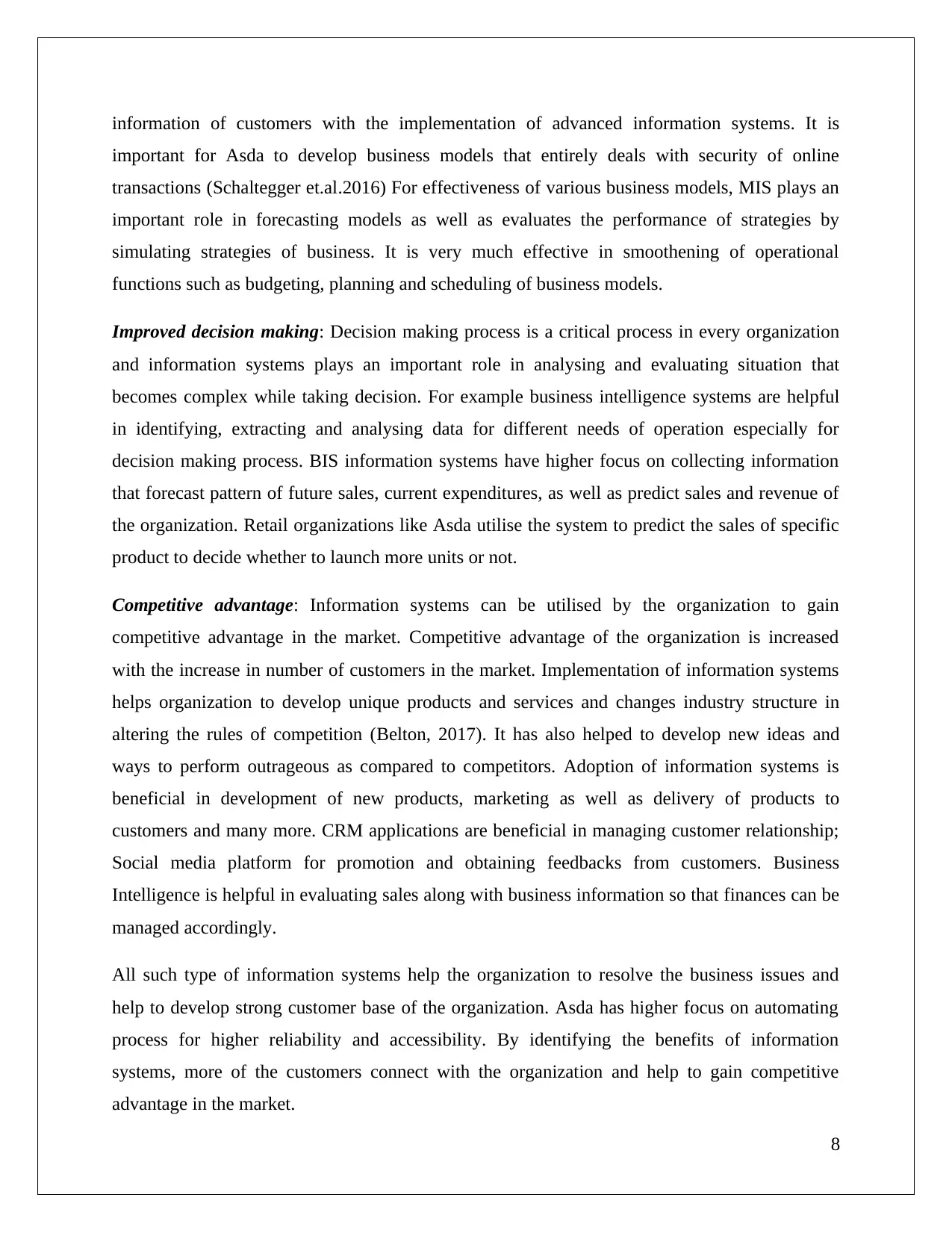
information of customers with the implementation of advanced information systems. It is
important for Asda to develop business models that entirely deals with security of online
transactions (Schaltegger et.al.2016) For effectiveness of various business models, MIS plays an
important role in forecasting models as well as evaluates the performance of strategies by
simulating strategies of business. It is very much effective in smoothening of operational
functions such as budgeting, planning and scheduling of business models.
Improved decision making: Decision making process is a critical process in every organization
and information systems plays an important role in analysing and evaluating situation that
becomes complex while taking decision. For example business intelligence systems are helpful
in identifying, extracting and analysing data for different needs of operation especially for
decision making process. BIS information systems have higher focus on collecting information
that forecast pattern of future sales, current expenditures, as well as predict sales and revenue of
the organization. Retail organizations like Asda utilise the system to predict the sales of specific
product to decide whether to launch more units or not.
Competitive advantage: Information systems can be utilised by the organization to gain
competitive advantage in the market. Competitive advantage of the organization is increased
with the increase in number of customers in the market. Implementation of information systems
helps organization to develop unique products and services and changes industry structure in
altering the rules of competition (Belton, 2017). It has also helped to develop new ideas and
ways to perform outrageous as compared to competitors. Adoption of information systems is
beneficial in development of new products, marketing as well as delivery of products to
customers and many more. CRM applications are beneficial in managing customer relationship;
Social media platform for promotion and obtaining feedbacks from customers. Business
Intelligence is helpful in evaluating sales along with business information so that finances can be
managed accordingly.
All such type of information systems help the organization to resolve the business issues and
help to develop strong customer base of the organization. Asda has higher focus on automating
process for higher reliability and accessibility. By identifying the benefits of information
systems, more of the customers connect with the organization and help to gain competitive
advantage in the market.
8
important for Asda to develop business models that entirely deals with security of online
transactions (Schaltegger et.al.2016) For effectiveness of various business models, MIS plays an
important role in forecasting models as well as evaluates the performance of strategies by
simulating strategies of business. It is very much effective in smoothening of operational
functions such as budgeting, planning and scheduling of business models.
Improved decision making: Decision making process is a critical process in every organization
and information systems plays an important role in analysing and evaluating situation that
becomes complex while taking decision. For example business intelligence systems are helpful
in identifying, extracting and analysing data for different needs of operation especially for
decision making process. BIS information systems have higher focus on collecting information
that forecast pattern of future sales, current expenditures, as well as predict sales and revenue of
the organization. Retail organizations like Asda utilise the system to predict the sales of specific
product to decide whether to launch more units or not.
Competitive advantage: Information systems can be utilised by the organization to gain
competitive advantage in the market. Competitive advantage of the organization is increased
with the increase in number of customers in the market. Implementation of information systems
helps organization to develop unique products and services and changes industry structure in
altering the rules of competition (Belton, 2017). It has also helped to develop new ideas and
ways to perform outrageous as compared to competitors. Adoption of information systems is
beneficial in development of new products, marketing as well as delivery of products to
customers and many more. CRM applications are beneficial in managing customer relationship;
Social media platform for promotion and obtaining feedbacks from customers. Business
Intelligence is helpful in evaluating sales along with business information so that finances can be
managed accordingly.
All such type of information systems help the organization to resolve the business issues and
help to develop strong customer base of the organization. Asda has higher focus on automating
process for higher reliability and accessibility. By identifying the benefits of information
systems, more of the customers connect with the organization and help to gain competitive
advantage in the market.
8
Secure Best Marks with AI Grader
Need help grading? Try our AI Grader for instant feedback on your assignments.
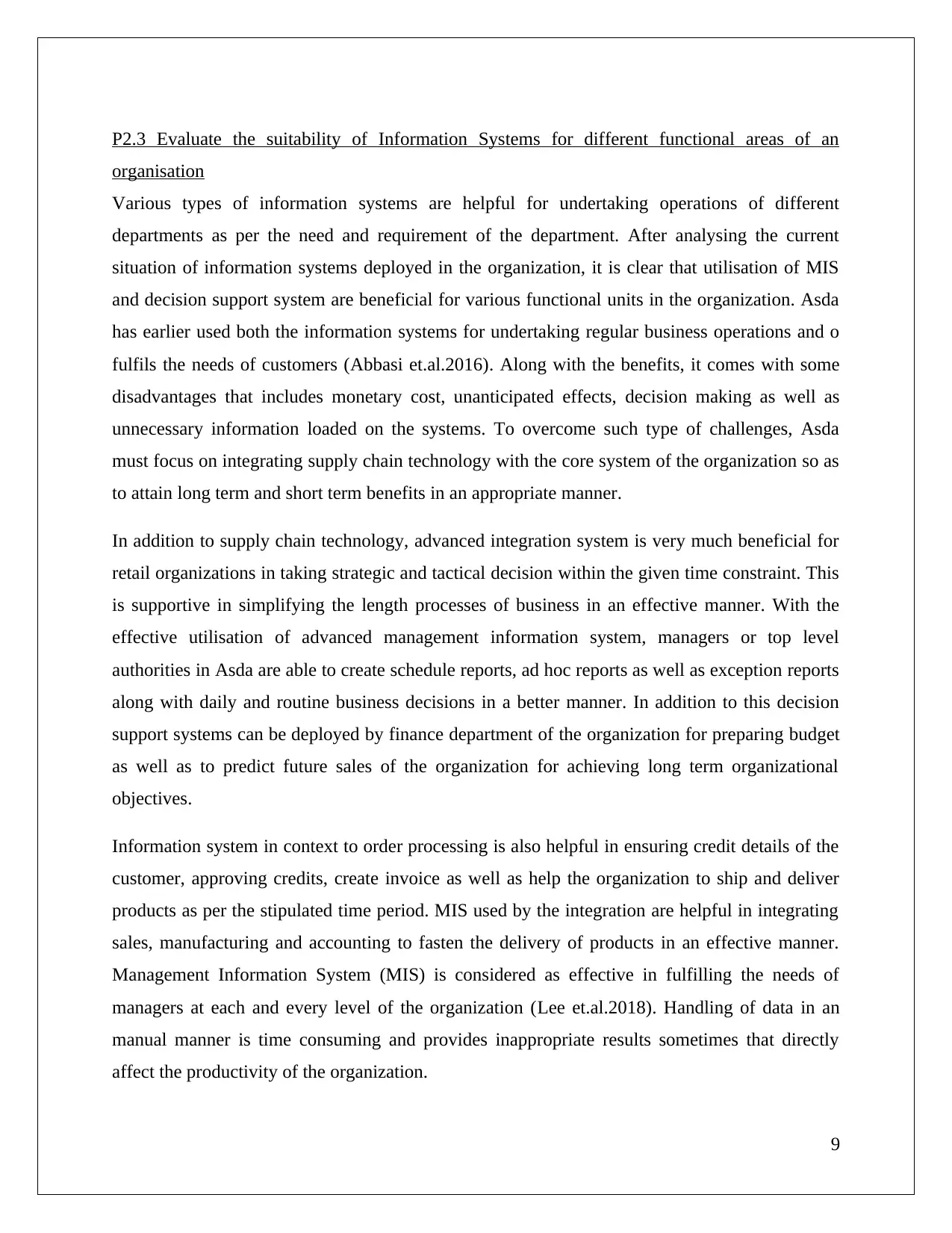
P2.3 Evaluate the suitability of Information Systems for different functional areas of an
organisation
Various types of information systems are helpful for undertaking operations of different
departments as per the need and requirement of the department. After analysing the current
situation of information systems deployed in the organization, it is clear that utilisation of MIS
and decision support system are beneficial for various functional units in the organization. Asda
has earlier used both the information systems for undertaking regular business operations and o
fulfils the needs of customers (Abbasi et.al.2016). Along with the benefits, it comes with some
disadvantages that includes monetary cost, unanticipated effects, decision making as well as
unnecessary information loaded on the systems. To overcome such type of challenges, Asda
must focus on integrating supply chain technology with the core system of the organization so as
to attain long term and short term benefits in an appropriate manner.
In addition to supply chain technology, advanced integration system is very much beneficial for
retail organizations in taking strategic and tactical decision within the given time constraint. This
is supportive in simplifying the length processes of business in an effective manner. With the
effective utilisation of advanced management information system, managers or top level
authorities in Asda are able to create schedule reports, ad hoc reports as well as exception reports
along with daily and routine business decisions in a better manner. In addition to this decision
support systems can be deployed by finance department of the organization for preparing budget
as well as to predict future sales of the organization for achieving long term organizational
objectives.
Information system in context to order processing is also helpful in ensuring credit details of the
customer, approving credits, create invoice as well as help the organization to ship and deliver
products as per the stipulated time period. MIS used by the integration are helpful in integrating
sales, manufacturing and accounting to fasten the delivery of products in an effective manner.
Management Information System (MIS) is considered as effective in fulfilling the needs of
managers at each and every level of the organization (Lee et.al.2018). Handling of data in an
manual manner is time consuming and provides inappropriate results sometimes that directly
affect the productivity of the organization.
9
organisation
Various types of information systems are helpful for undertaking operations of different
departments as per the need and requirement of the department. After analysing the current
situation of information systems deployed in the organization, it is clear that utilisation of MIS
and decision support system are beneficial for various functional units in the organization. Asda
has earlier used both the information systems for undertaking regular business operations and o
fulfils the needs of customers (Abbasi et.al.2016). Along with the benefits, it comes with some
disadvantages that includes monetary cost, unanticipated effects, decision making as well as
unnecessary information loaded on the systems. To overcome such type of challenges, Asda
must focus on integrating supply chain technology with the core system of the organization so as
to attain long term and short term benefits in an appropriate manner.
In addition to supply chain technology, advanced integration system is very much beneficial for
retail organizations in taking strategic and tactical decision within the given time constraint. This
is supportive in simplifying the length processes of business in an effective manner. With the
effective utilisation of advanced management information system, managers or top level
authorities in Asda are able to create schedule reports, ad hoc reports as well as exception reports
along with daily and routine business decisions in a better manner. In addition to this decision
support systems can be deployed by finance department of the organization for preparing budget
as well as to predict future sales of the organization for achieving long term organizational
objectives.
Information system in context to order processing is also helpful in ensuring credit details of the
customer, approving credits, create invoice as well as help the organization to ship and deliver
products as per the stipulated time period. MIS used by the integration are helpful in integrating
sales, manufacturing and accounting to fasten the delivery of products in an effective manner.
Management Information System (MIS) is considered as effective in fulfilling the needs of
managers at each and every level of the organization (Lee et.al.2018). Handling of data in an
manual manner is time consuming and provides inappropriate results sometimes that directly
affect the productivity of the organization.
9

In addition to MIS, human resource management systems are beneficial in tracking information
of human capital in the organization. This type of information system is supportive in monitoring
the attendance of employees, evaluating their performance, salary calculation and many more
tasks which are done in an effective manner. Human resource management simplify all the task
and help to perform in an effective manner without any errors. It also facilitates employees by
tracking their own record, salary slips, and time off balances, transaction records and many more.
Retail organizations like Asda have to manage wide range of products and associated
information which is a critical task. For managing such a large amount of data organization must
focus on implementing Data Warehouse System (DWS) to handle a lot of data for various
business operations (Vaisman and Zimányi, 2014). This type of information system is supportive
in placing data in structured and organized manner. It saves lot of time as it provides facility of
accessing the data which saves lots of efforts as well. DWS provides the facility of solving
critical situations in an effective manner which is beneficial for the organization.
By discussing all the suitability and availability of information systems, it has been identified
that decision support system does not allow employees of Asda and other retail organizations to
analyse internal as well as external elements on regular basis. This type of system is beneficial in
regular changing and usual situations like currency exchange, market fluctuation, etc.
10
of human capital in the organization. This type of information system is supportive in monitoring
the attendance of employees, evaluating their performance, salary calculation and many more
tasks which are done in an effective manner. Human resource management simplify all the task
and help to perform in an effective manner without any errors. It also facilitates employees by
tracking their own record, salary slips, and time off balances, transaction records and many more.
Retail organizations like Asda have to manage wide range of products and associated
information which is a critical task. For managing such a large amount of data organization must
focus on implementing Data Warehouse System (DWS) to handle a lot of data for various
business operations (Vaisman and Zimányi, 2014). This type of information system is supportive
in placing data in structured and organized manner. It saves lot of time as it provides facility of
accessing the data which saves lots of efforts as well. DWS provides the facility of solving
critical situations in an effective manner which is beneficial for the organization.
By discussing all the suitability and availability of information systems, it has been identified
that decision support system does not allow employees of Asda and other retail organizations to
analyse internal as well as external elements on regular basis. This type of system is beneficial in
regular changing and usual situations like currency exchange, market fluctuation, etc.
10
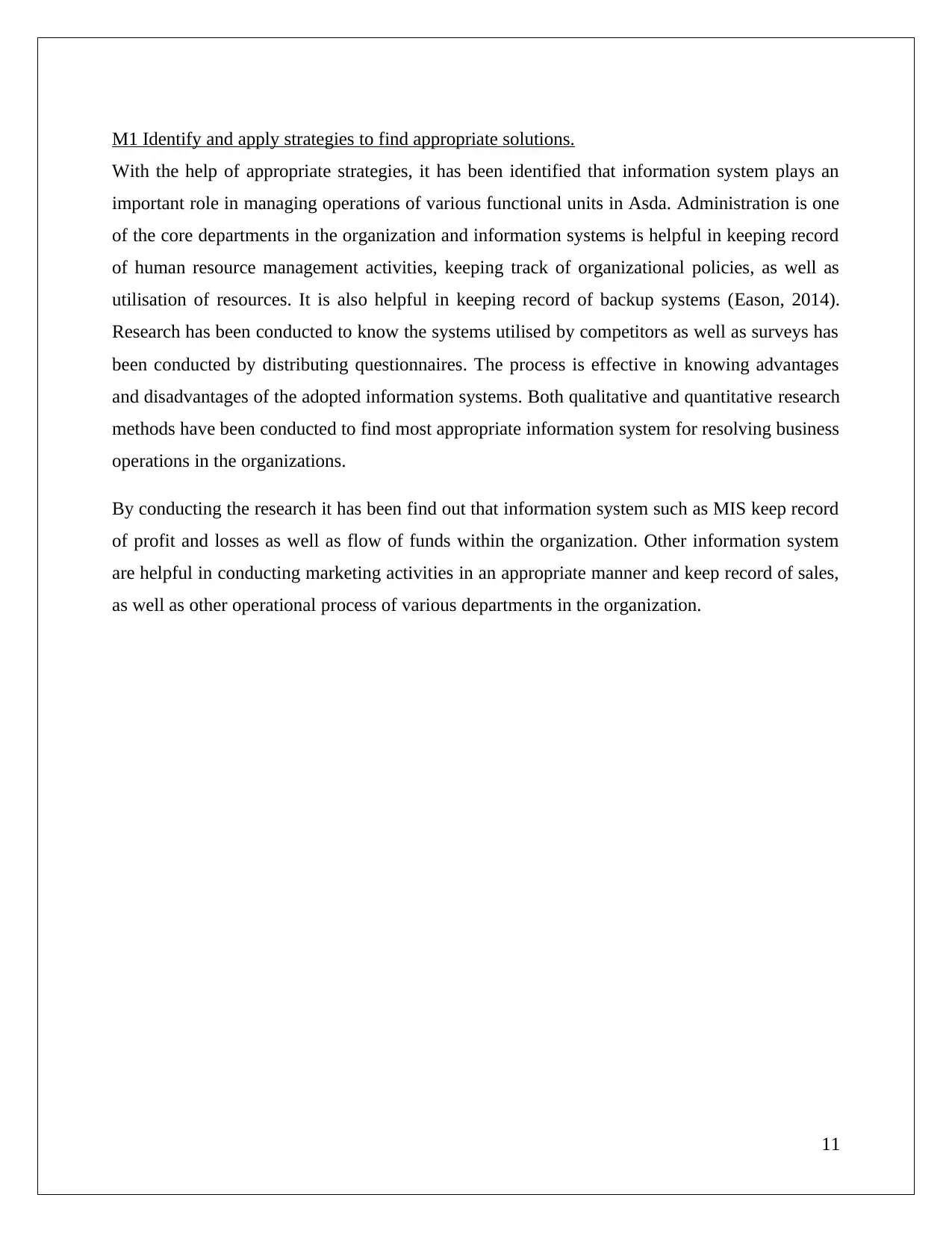
M1 Identify and apply strategies to find appropriate solutions.
With the help of appropriate strategies, it has been identified that information system plays an
important role in managing operations of various functional units in Asda. Administration is one
of the core departments in the organization and information systems is helpful in keeping record
of human resource management activities, keeping track of organizational policies, as well as
utilisation of resources. It is also helpful in keeping record of backup systems (Eason, 2014).
Research has been conducted to know the systems utilised by competitors as well as surveys has
been conducted by distributing questionnaires. The process is effective in knowing advantages
and disadvantages of the adopted information systems. Both qualitative and quantitative research
methods have been conducted to find most appropriate information system for resolving business
operations in the organizations.
By conducting the research it has been find out that information system such as MIS keep record
of profit and losses as well as flow of funds within the organization. Other information system
are helpful in conducting marketing activities in an appropriate manner and keep record of sales,
as well as other operational process of various departments in the organization.
11
With the help of appropriate strategies, it has been identified that information system plays an
important role in managing operations of various functional units in Asda. Administration is one
of the core departments in the organization and information systems is helpful in keeping record
of human resource management activities, keeping track of organizational policies, as well as
utilisation of resources. It is also helpful in keeping record of backup systems (Eason, 2014).
Research has been conducted to know the systems utilised by competitors as well as surveys has
been conducted by distributing questionnaires. The process is effective in knowing advantages
and disadvantages of the adopted information systems. Both qualitative and quantitative research
methods have been conducted to find most appropriate information system for resolving business
operations in the organizations.
By conducting the research it has been find out that information system such as MIS keep record
of profit and losses as well as flow of funds within the organization. Other information system
are helpful in conducting marketing activities in an appropriate manner and keep record of sales,
as well as other operational process of various departments in the organization.
11
Paraphrase This Document
Need a fresh take? Get an instant paraphrase of this document with our AI Paraphraser
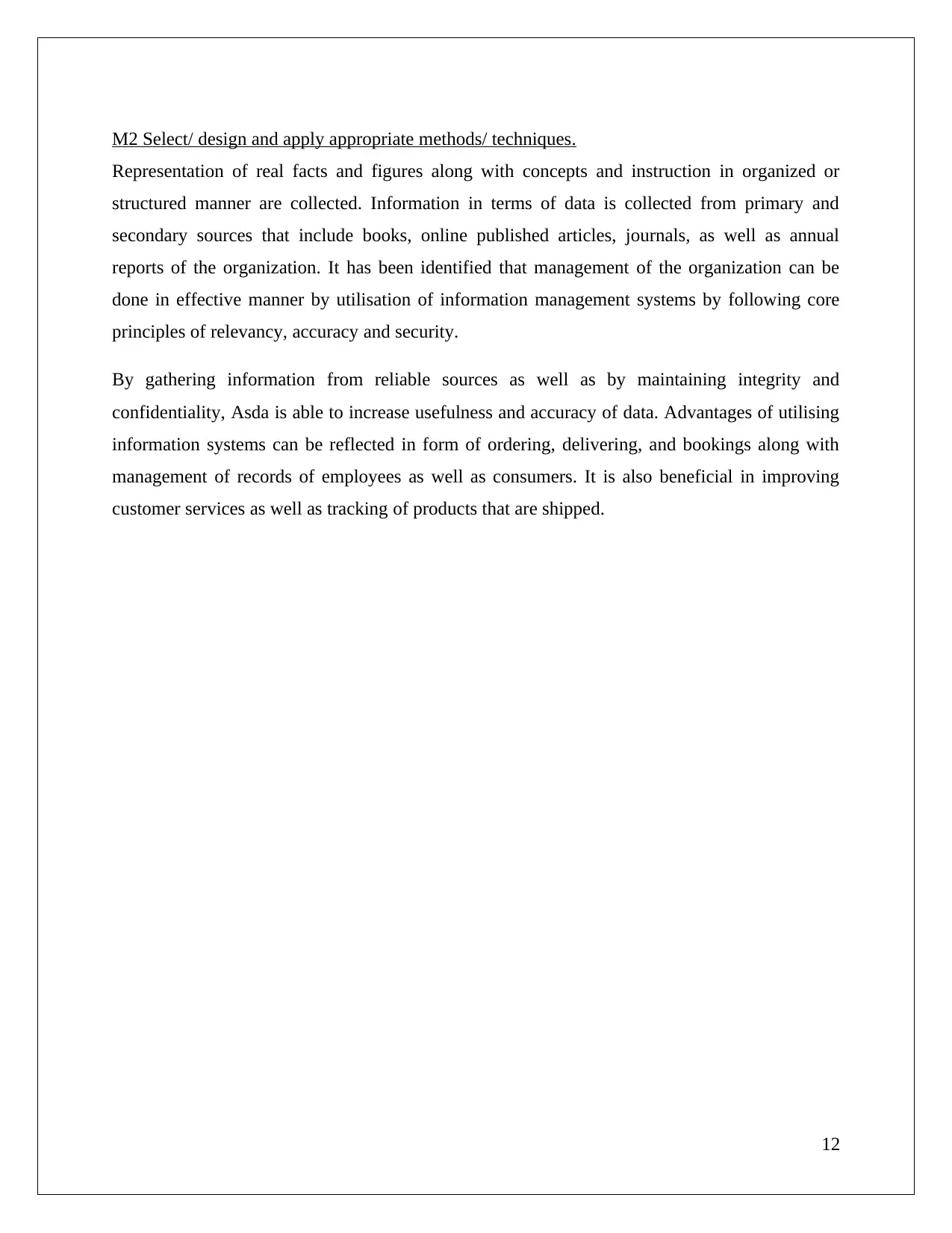
M2 Select/ design and apply appropriate methods/ techniques.
Representation of real facts and figures along with concepts and instruction in organized or
structured manner are collected. Information in terms of data is collected from primary and
secondary sources that include books, online published articles, journals, as well as annual
reports of the organization. It has been identified that management of the organization can be
done in effective manner by utilisation of information management systems by following core
principles of relevancy, accuracy and security.
By gathering information from reliable sources as well as by maintaining integrity and
confidentiality, Asda is able to increase usefulness and accuracy of data. Advantages of utilising
information systems can be reflected in form of ordering, delivering, and bookings along with
management of records of employees as well as consumers. It is also beneficial in improving
customer services as well as tracking of products that are shipped.
12
Representation of real facts and figures along with concepts and instruction in organized or
structured manner are collected. Information in terms of data is collected from primary and
secondary sources that include books, online published articles, journals, as well as annual
reports of the organization. It has been identified that management of the organization can be
done in effective manner by utilisation of information management systems by following core
principles of relevancy, accuracy and security.
By gathering information from reliable sources as well as by maintaining integrity and
confidentiality, Asda is able to increase usefulness and accuracy of data. Advantages of utilising
information systems can be reflected in form of ordering, delivering, and bookings along with
management of records of employees as well as consumers. It is also beneficial in improving
customer services as well as tracking of products that are shipped.
12

13
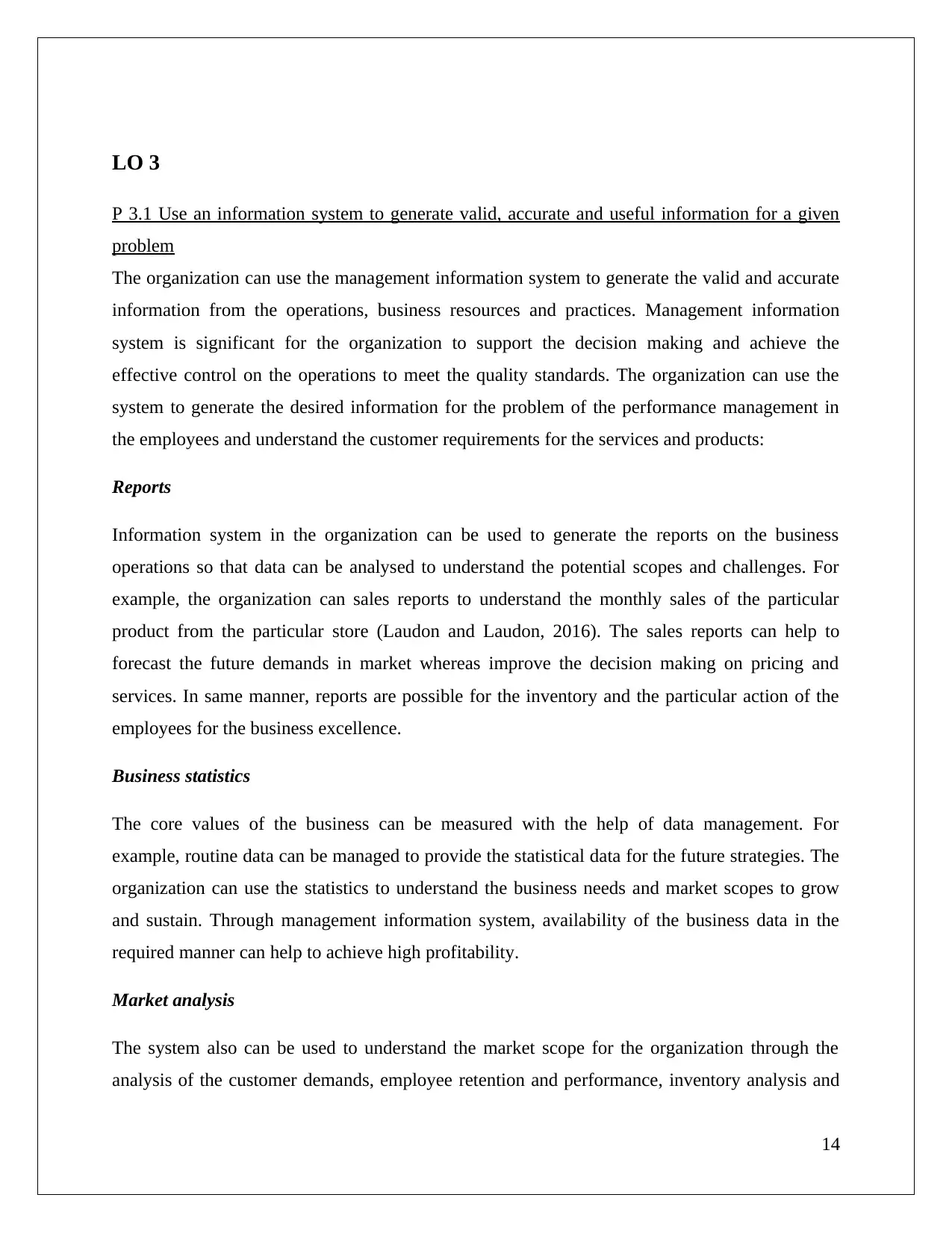
LO 3
P 3.1 Use an information system to generate valid, accurate and useful information for a given
problem
The organization can use the management information system to generate the valid and accurate
information from the operations, business resources and practices. Management information
system is significant for the organization to support the decision making and achieve the
effective control on the operations to meet the quality standards. The organization can use the
system to generate the desired information for the problem of the performance management in
the employees and understand the customer requirements for the services and products:
Reports
Information system in the organization can be used to generate the reports on the business
operations so that data can be analysed to understand the potential scopes and challenges. For
example, the organization can sales reports to understand the monthly sales of the particular
product from the particular store (Laudon and Laudon, 2016). The sales reports can help to
forecast the future demands in market whereas improve the decision making on pricing and
services. In same manner, reports are possible for the inventory and the particular action of the
employees for the business excellence.
Business statistics
The core values of the business can be measured with the help of data management. For
example, routine data can be managed to provide the statistical data for the future strategies. The
organization can use the statistics to understand the business needs and market scopes to grow
and sustain. Through management information system, availability of the business data in the
required manner can help to achieve high profitability.
Market analysis
The system also can be used to understand the market scope for the organization through the
analysis of the customer demands, employee retention and performance, inventory analysis and
14
P 3.1 Use an information system to generate valid, accurate and useful information for a given
problem
The organization can use the management information system to generate the valid and accurate
information from the operations, business resources and practices. Management information
system is significant for the organization to support the decision making and achieve the
effective control on the operations to meet the quality standards. The organization can use the
system to generate the desired information for the problem of the performance management in
the employees and understand the customer requirements for the services and products:
Reports
Information system in the organization can be used to generate the reports on the business
operations so that data can be analysed to understand the potential scopes and challenges. For
example, the organization can sales reports to understand the monthly sales of the particular
product from the particular store (Laudon and Laudon, 2016). The sales reports can help to
forecast the future demands in market whereas improve the decision making on pricing and
services. In same manner, reports are possible for the inventory and the particular action of the
employees for the business excellence.
Business statistics
The core values of the business can be measured with the help of data management. For
example, routine data can be managed to provide the statistical data for the future strategies. The
organization can use the statistics to understand the business needs and market scopes to grow
and sustain. Through management information system, availability of the business data in the
required manner can help to achieve high profitability.
Market analysis
The system also can be used to understand the market scope for the organization through the
analysis of the customer demands, employee retention and performance, inventory analysis and
14
Secure Best Marks with AI Grader
Need help grading? Try our AI Grader for instant feedback on your assignments.
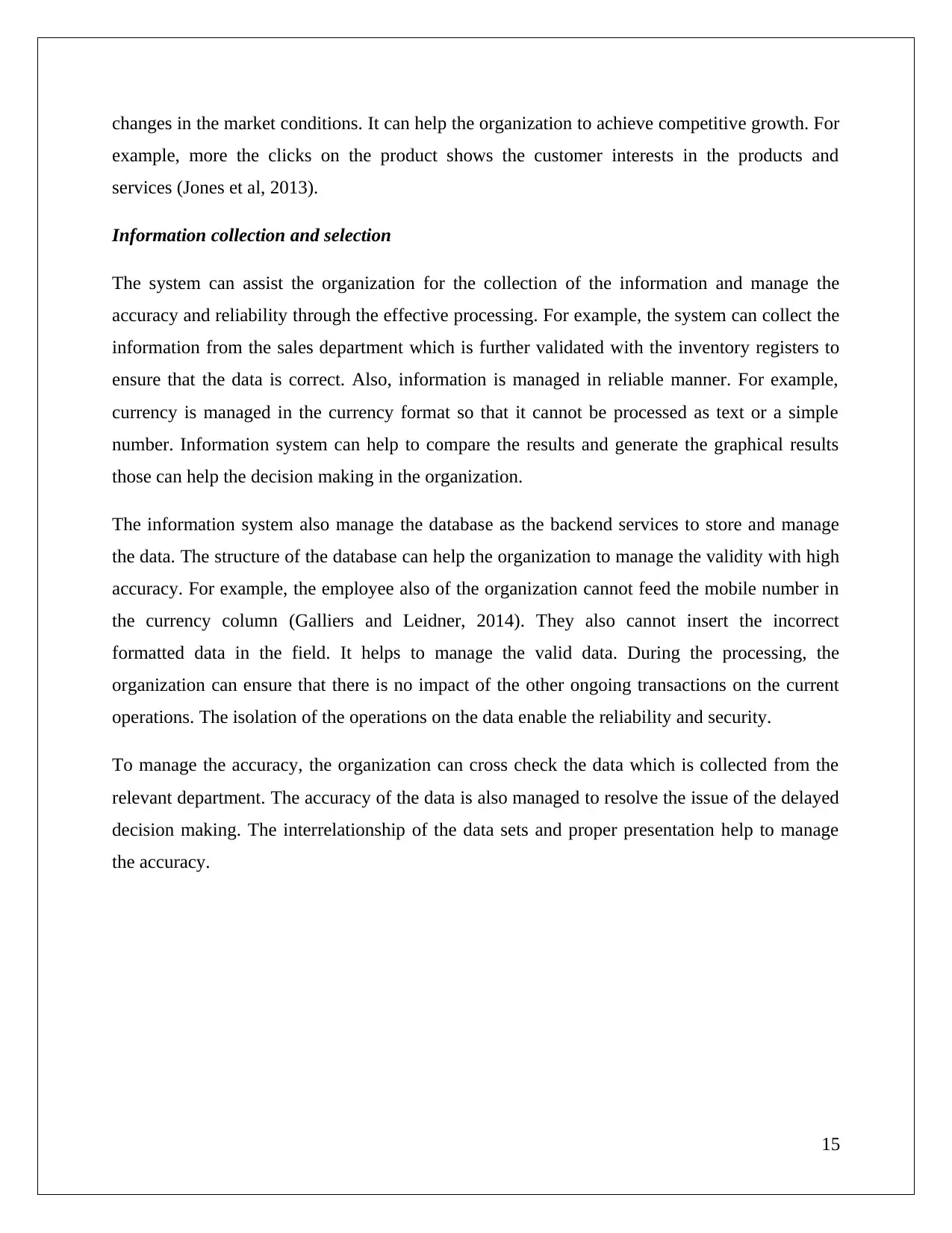
changes in the market conditions. It can help the organization to achieve competitive growth. For
example, more the clicks on the product shows the customer interests in the products and
services (Jones et al, 2013).
Information collection and selection
The system can assist the organization for the collection of the information and manage the
accuracy and reliability through the effective processing. For example, the system can collect the
information from the sales department which is further validated with the inventory registers to
ensure that the data is correct. Also, information is managed in reliable manner. For example,
currency is managed in the currency format so that it cannot be processed as text or a simple
number. Information system can help to compare the results and generate the graphical results
those can help the decision making in the organization.
The information system also manage the database as the backend services to store and manage
the data. The structure of the database can help the organization to manage the validity with high
accuracy. For example, the employee also of the organization cannot feed the mobile number in
the currency column (Galliers and Leidner, 2014). They also cannot insert the incorrect
formatted data in the field. It helps to manage the valid data. During the processing, the
organization can ensure that there is no impact of the other ongoing transactions on the current
operations. The isolation of the operations on the data enable the reliability and security.
To manage the accuracy, the organization can cross check the data which is collected from the
relevant department. The accuracy of the data is also managed to resolve the issue of the delayed
decision making. The interrelationship of the data sets and proper presentation help to manage
the accuracy.
15
example, more the clicks on the product shows the customer interests in the products and
services (Jones et al, 2013).
Information collection and selection
The system can assist the organization for the collection of the information and manage the
accuracy and reliability through the effective processing. For example, the system can collect the
information from the sales department which is further validated with the inventory registers to
ensure that the data is correct. Also, information is managed in reliable manner. For example,
currency is managed in the currency format so that it cannot be processed as text or a simple
number. Information system can help to compare the results and generate the graphical results
those can help the decision making in the organization.
The information system also manage the database as the backend services to store and manage
the data. The structure of the database can help the organization to manage the validity with high
accuracy. For example, the employee also of the organization cannot feed the mobile number in
the currency column (Galliers and Leidner, 2014). They also cannot insert the incorrect
formatted data in the field. It helps to manage the valid data. During the processing, the
organization can ensure that there is no impact of the other ongoing transactions on the current
operations. The isolation of the operations on the data enable the reliability and security.
To manage the accuracy, the organization can cross check the data which is collected from the
relevant department. The accuracy of the data is also managed to resolve the issue of the delayed
decision making. The interrelationship of the data sets and proper presentation help to manage
the accuracy.
15
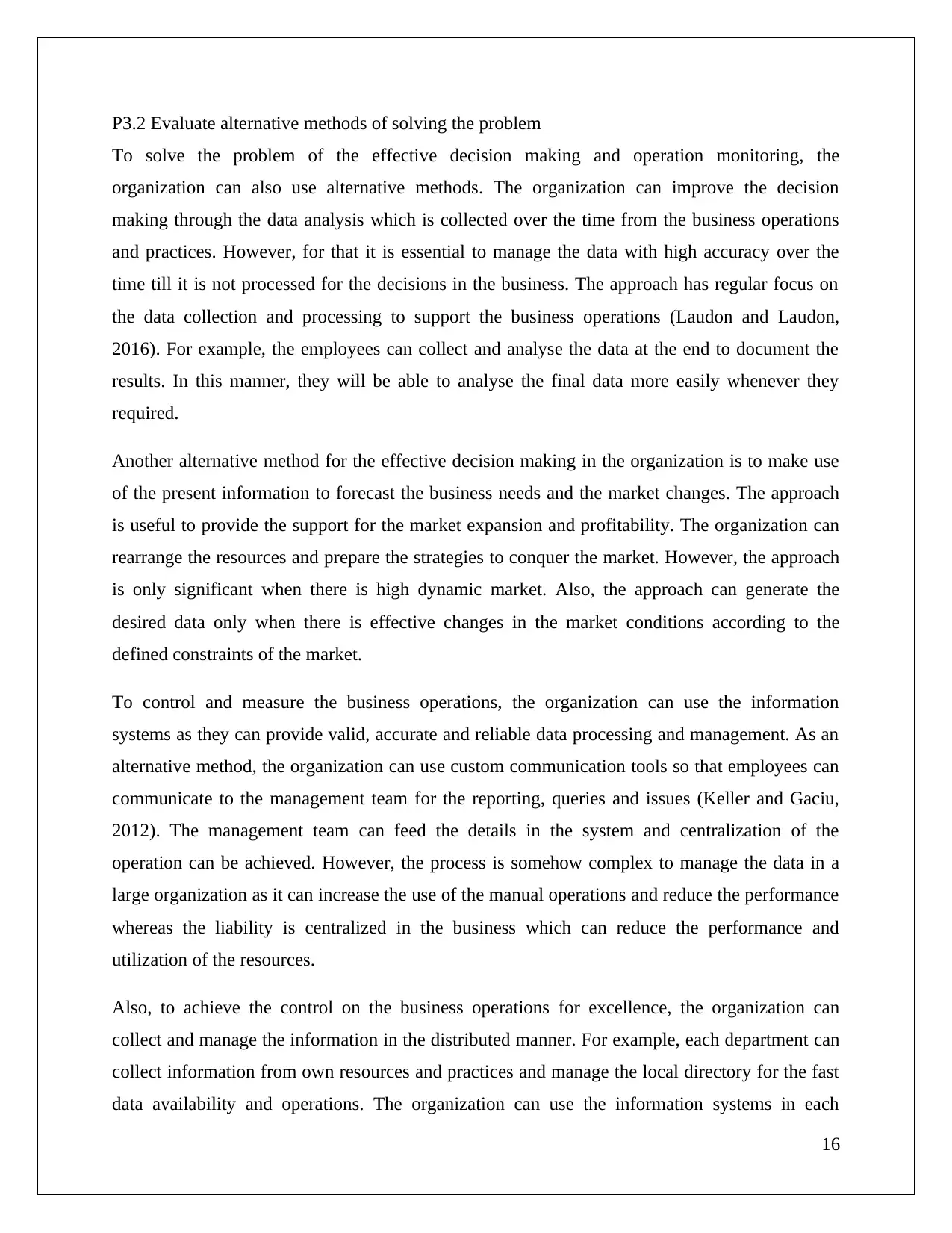
P3.2 Evaluate alternative methods of solving the problem
To solve the problem of the effective decision making and operation monitoring, the
organization can also use alternative methods. The organization can improve the decision
making through the data analysis which is collected over the time from the business operations
and practices. However, for that it is essential to manage the data with high accuracy over the
time till it is not processed for the decisions in the business. The approach has regular focus on
the data collection and processing to support the business operations (Laudon and Laudon,
2016). For example, the employees can collect and analyse the data at the end to document the
results. In this manner, they will be able to analyse the final data more easily whenever they
required.
Another alternative method for the effective decision making in the organization is to make use
of the present information to forecast the business needs and the market changes. The approach
is useful to provide the support for the market expansion and profitability. The organization can
rearrange the resources and prepare the strategies to conquer the market. However, the approach
is only significant when there is high dynamic market. Also, the approach can generate the
desired data only when there is effective changes in the market conditions according to the
defined constraints of the market.
To control and measure the business operations, the organization can use the information
systems as they can provide valid, accurate and reliable data processing and management. As an
alternative method, the organization can use custom communication tools so that employees can
communicate to the management team for the reporting, queries and issues (Keller and Gaciu,
2012). The management team can feed the details in the system and centralization of the
operation can be achieved. However, the process is somehow complex to manage the data in a
large organization as it can increase the use of the manual operations and reduce the performance
whereas the liability is centralized in the business which can reduce the performance and
utilization of the resources.
Also, to achieve the control on the business operations for excellence, the organization can
collect and manage the information in the distributed manner. For example, each department can
collect information from own resources and practices and manage the local directory for the fast
data availability and operations. The organization can use the information systems in each
16
To solve the problem of the effective decision making and operation monitoring, the
organization can also use alternative methods. The organization can improve the decision
making through the data analysis which is collected over the time from the business operations
and practices. However, for that it is essential to manage the data with high accuracy over the
time till it is not processed for the decisions in the business. The approach has regular focus on
the data collection and processing to support the business operations (Laudon and Laudon,
2016). For example, the employees can collect and analyse the data at the end to document the
results. In this manner, they will be able to analyse the final data more easily whenever they
required.
Another alternative method for the effective decision making in the organization is to make use
of the present information to forecast the business needs and the market changes. The approach
is useful to provide the support for the market expansion and profitability. The organization can
rearrange the resources and prepare the strategies to conquer the market. However, the approach
is only significant when there is high dynamic market. Also, the approach can generate the
desired data only when there is effective changes in the market conditions according to the
defined constraints of the market.
To control and measure the business operations, the organization can use the information
systems as they can provide valid, accurate and reliable data processing and management. As an
alternative method, the organization can use custom communication tools so that employees can
communicate to the management team for the reporting, queries and issues (Keller and Gaciu,
2012). The management team can feed the details in the system and centralization of the
operation can be achieved. However, the process is somehow complex to manage the data in a
large organization as it can increase the use of the manual operations and reduce the performance
whereas the liability is centralized in the business which can reduce the performance and
utilization of the resources.
Also, to achieve the control on the business operations for excellence, the organization can
collect and manage the information in the distributed manner. For example, each department can
collect information from own resources and practices and manage the local directory for the fast
data availability and operations. The organization can use the information systems in each
16
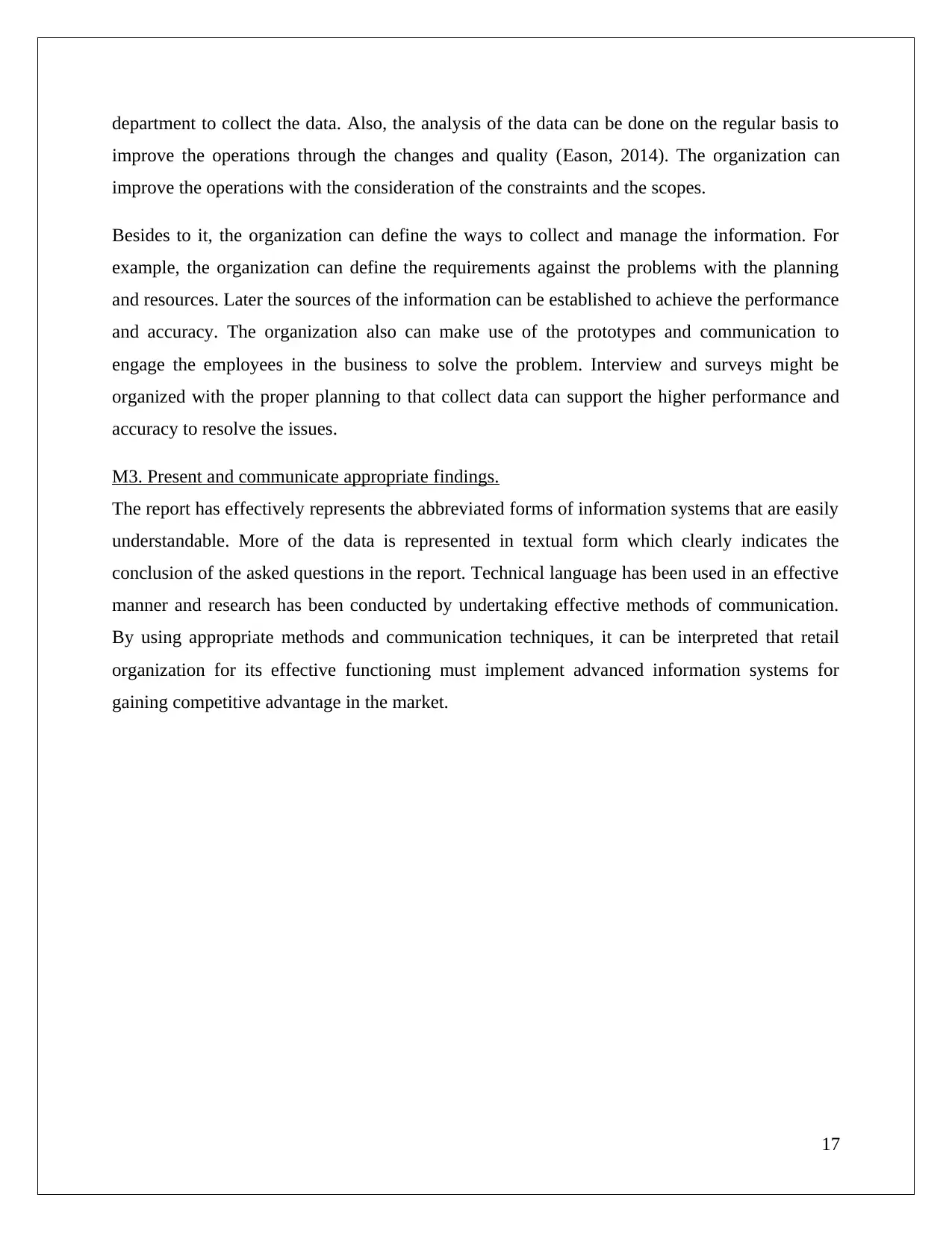
department to collect the data. Also, the analysis of the data can be done on the regular basis to
improve the operations through the changes and quality (Eason, 2014). The organization can
improve the operations with the consideration of the constraints and the scopes.
Besides to it, the organization can define the ways to collect and manage the information. For
example, the organization can define the requirements against the problems with the planning
and resources. Later the sources of the information can be established to achieve the performance
and accuracy. The organization also can make use of the prototypes and communication to
engage the employees in the business to solve the problem. Interview and surveys might be
organized with the proper planning to that collect data can support the higher performance and
accuracy to resolve the issues.
M3. Present and communicate appropriate findings.
The report has effectively represents the abbreviated forms of information systems that are easily
understandable. More of the data is represented in textual form which clearly indicates the
conclusion of the asked questions in the report. Technical language has been used in an effective
manner and research has been conducted by undertaking effective methods of communication.
By using appropriate methods and communication techniques, it can be interpreted that retail
organization for its effective functioning must implement advanced information systems for
gaining competitive advantage in the market.
17
improve the operations through the changes and quality (Eason, 2014). The organization can
improve the operations with the consideration of the constraints and the scopes.
Besides to it, the organization can define the ways to collect and manage the information. For
example, the organization can define the requirements against the problems with the planning
and resources. Later the sources of the information can be established to achieve the performance
and accuracy. The organization also can make use of the prototypes and communication to
engage the employees in the business to solve the problem. Interview and surveys might be
organized with the proper planning to that collect data can support the higher performance and
accuracy to resolve the issues.
M3. Present and communicate appropriate findings.
The report has effectively represents the abbreviated forms of information systems that are easily
understandable. More of the data is represented in textual form which clearly indicates the
conclusion of the asked questions in the report. Technical language has been used in an effective
manner and research has been conducted by undertaking effective methods of communication.
By using appropriate methods and communication techniques, it can be interpreted that retail
organization for its effective functioning must implement advanced information systems for
gaining competitive advantage in the market.
17
Paraphrase This Document
Need a fresh take? Get an instant paraphrase of this document with our AI Paraphraser

sConclusion
From the above report it has been identified that utilisation of information management system is
important in resolving business issues and help to gain competitive advantage in the market.
Different functional units like fiancé, human resource, production, marketing, sales and many
more must adopt information systems as per the needs of business process to simplify the
activities in less complex manner. Information systems play an important role in identifying loop
holes in the process and simplify the process of decision making as well. There exist large
number of information systems and appropriate must be chosen as per organizational needs and
demands.
18
From the above report it has been identified that utilisation of information management system is
important in resolving business issues and help to gain competitive advantage in the market.
Different functional units like fiancé, human resource, production, marketing, sales and many
more must adopt information systems as per the needs of business process to simplify the
activities in less complex manner. Information systems play an important role in identifying loop
holes in the process and simplify the process of decision making as well. There exist large
number of information systems and appropriate must be chosen as per organizational needs and
demands.
18
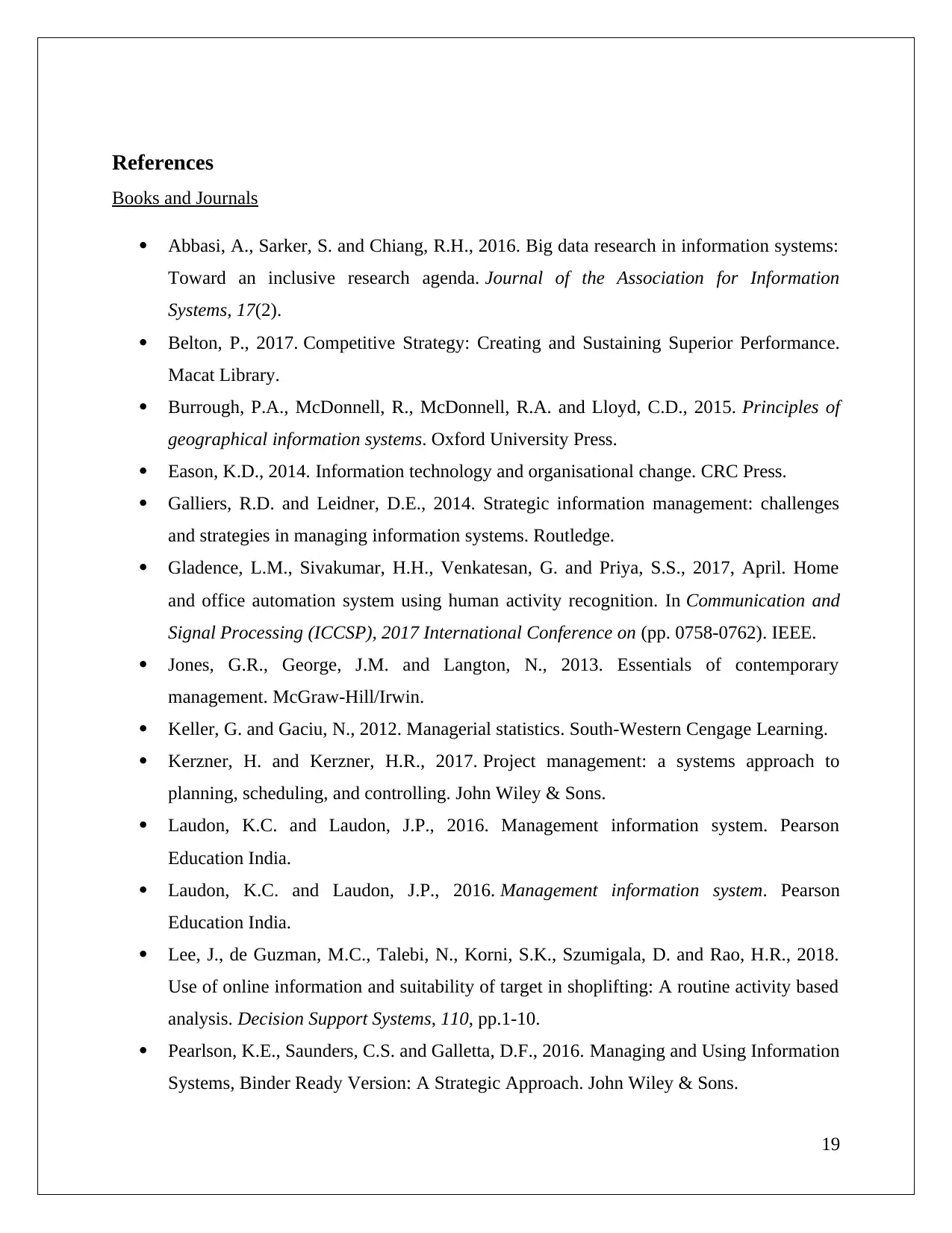
References
Books and Journals
Abbasi, A., Sarker, S. and Chiang, R.H., 2016. Big data research in information systems:
Toward an inclusive research agenda. Journal of the Association for Information
Systems, 17(2).
Belton, P., 2017. Competitive Strategy: Creating and Sustaining Superior Performance.
Macat Library.
Burrough, P.A., McDonnell, R., McDonnell, R.A. and Lloyd, C.D., 2015. Principles of
geographical information systems. Oxford University Press.
Eason, K.D., 2014. Information technology and organisational change. CRC Press.
Galliers, R.D. and Leidner, D.E., 2014. Strategic information management: challenges
and strategies in managing information systems. Routledge.
Gladence, L.M., Sivakumar, H.H., Venkatesan, G. and Priya, S.S., 2017, April. Home
and office automation system using human activity recognition. In Communication and
Signal Processing (ICCSP), 2017 International Conference on (pp. 0758-0762). IEEE.
Jones, G.R., George, J.M. and Langton, N., 2013. Essentials of contemporary
management. McGraw-Hill/Irwin.
Keller, G. and Gaciu, N., 2012. Managerial statistics. South-Western Cengage Learning.
Kerzner, H. and Kerzner, H.R., 2017. Project management: a systems approach to
planning, scheduling, and controlling. John Wiley & Sons.
Laudon, K.C. and Laudon, J.P., 2016. Management information system. Pearson
Education India.
Laudon, K.C. and Laudon, J.P., 2016. Management information system. Pearson
Education India.
Lee, J., de Guzman, M.C., Talebi, N., Korni, S.K., Szumigala, D. and Rao, H.R., 2018.
Use of online information and suitability of target in shoplifting: A routine activity based
analysis. Decision Support Systems, 110, pp.1-10.
Pearlson, K.E., Saunders, C.S. and Galletta, D.F., 2016. Managing and Using Information
Systems, Binder Ready Version: A Strategic Approach. John Wiley & Sons.
19
Books and Journals
Abbasi, A., Sarker, S. and Chiang, R.H., 2016. Big data research in information systems:
Toward an inclusive research agenda. Journal of the Association for Information
Systems, 17(2).
Belton, P., 2017. Competitive Strategy: Creating and Sustaining Superior Performance.
Macat Library.
Burrough, P.A., McDonnell, R., McDonnell, R.A. and Lloyd, C.D., 2015. Principles of
geographical information systems. Oxford University Press.
Eason, K.D., 2014. Information technology and organisational change. CRC Press.
Galliers, R.D. and Leidner, D.E., 2014. Strategic information management: challenges
and strategies in managing information systems. Routledge.
Gladence, L.M., Sivakumar, H.H., Venkatesan, G. and Priya, S.S., 2017, April. Home
and office automation system using human activity recognition. In Communication and
Signal Processing (ICCSP), 2017 International Conference on (pp. 0758-0762). IEEE.
Jones, G.R., George, J.M. and Langton, N., 2013. Essentials of contemporary
management. McGraw-Hill/Irwin.
Keller, G. and Gaciu, N., 2012. Managerial statistics. South-Western Cengage Learning.
Kerzner, H. and Kerzner, H.R., 2017. Project management: a systems approach to
planning, scheduling, and controlling. John Wiley & Sons.
Laudon, K.C. and Laudon, J.P., 2016. Management information system. Pearson
Education India.
Laudon, K.C. and Laudon, J.P., 2016. Management information system. Pearson
Education India.
Lee, J., de Guzman, M.C., Talebi, N., Korni, S.K., Szumigala, D. and Rao, H.R., 2018.
Use of online information and suitability of target in shoplifting: A routine activity based
analysis. Decision Support Systems, 110, pp.1-10.
Pearlson, K.E., Saunders, C.S. and Galletta, D.F., 2016. Managing and Using Information
Systems, Binder Ready Version: A Strategic Approach. John Wiley & Sons.
19
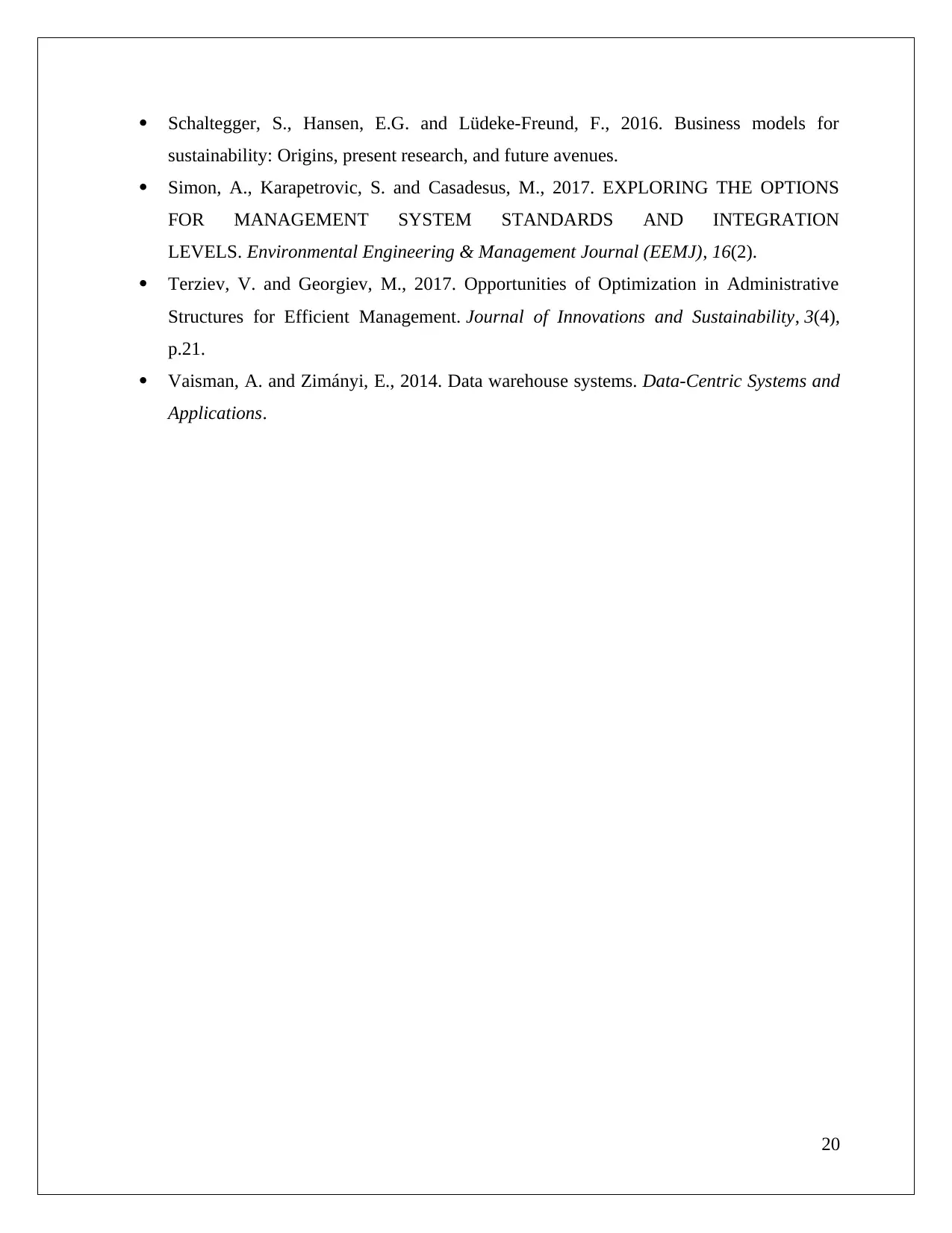
Schaltegger, S., Hansen, E.G. and Lüdeke-Freund, F., 2016. Business models for
sustainability: Origins, present research, and future avenues.
Simon, A., Karapetrovic, S. and Casadesus, M., 2017. EXPLORING THE OPTIONS
FOR MANAGEMENT SYSTEM STANDARDS AND INTEGRATION
LEVELS. Environmental Engineering & Management Journal (EEMJ), 16(2).
Terziev, V. and Georgiev, M., 2017. Opportunities of Optimization in Administrative
Structures for Efficient Management. Journal of Innovations and Sustainability, 3(4),
p.21.
Vaisman, A. and Zimányi, E., 2014. Data warehouse systems. Data-Centric Systems and
Applications.
20
sustainability: Origins, present research, and future avenues.
Simon, A., Karapetrovic, S. and Casadesus, M., 2017. EXPLORING THE OPTIONS
FOR MANAGEMENT SYSTEM STANDARDS AND INTEGRATION
LEVELS. Environmental Engineering & Management Journal (EEMJ), 16(2).
Terziev, V. and Georgiev, M., 2017. Opportunities of Optimization in Administrative
Structures for Efficient Management. Journal of Innovations and Sustainability, 3(4),
p.21.
Vaisman, A. and Zimányi, E., 2014. Data warehouse systems. Data-Centric Systems and
Applications.
20
1 out of 22
Related Documents
Your All-in-One AI-Powered Toolkit for Academic Success.
+13062052269
info@desklib.com
Available 24*7 on WhatsApp / Email
![[object Object]](/_next/static/media/star-bottom.7253800d.svg)
Unlock your academic potential
© 2024 | Zucol Services PVT LTD | All rights reserved.





